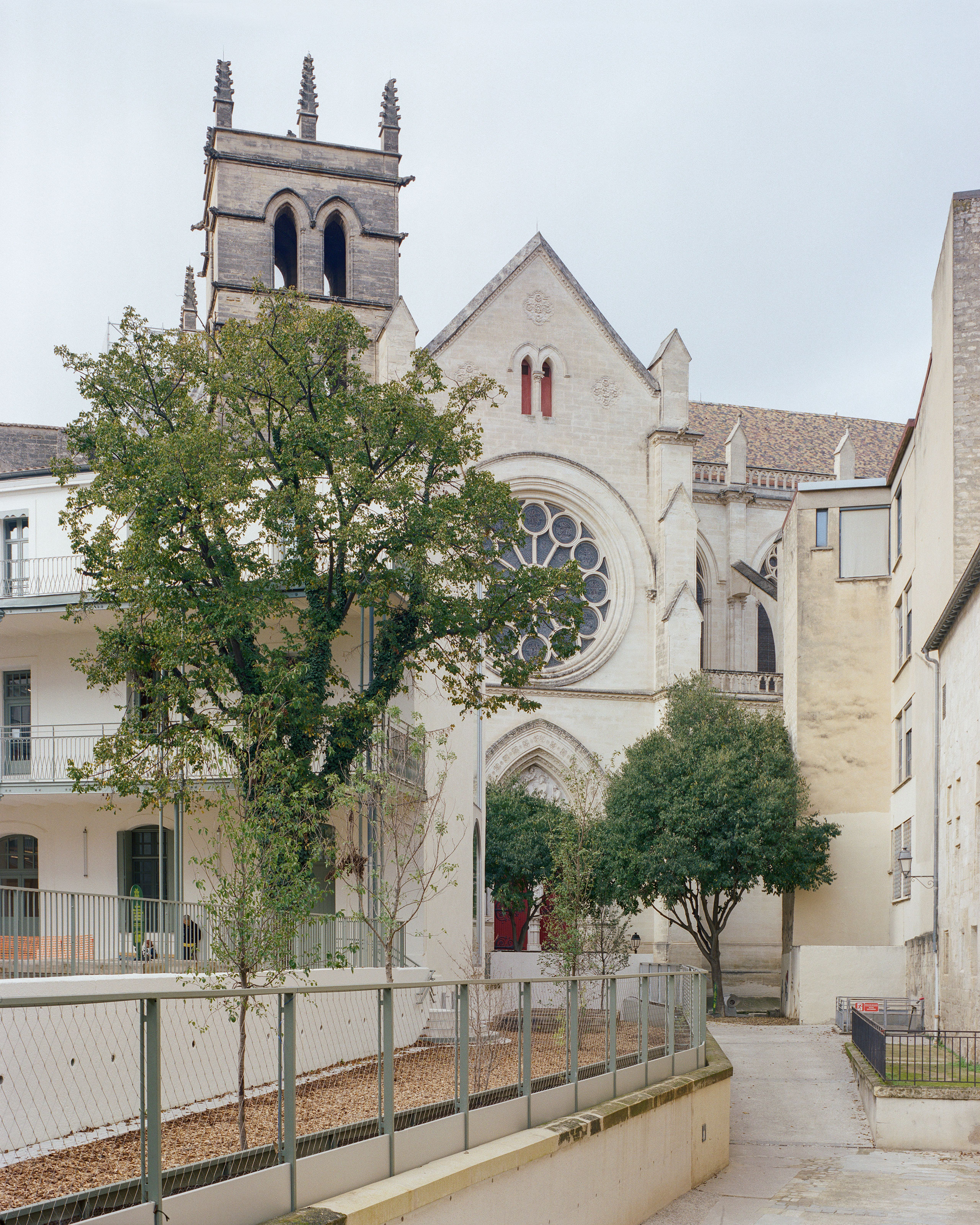
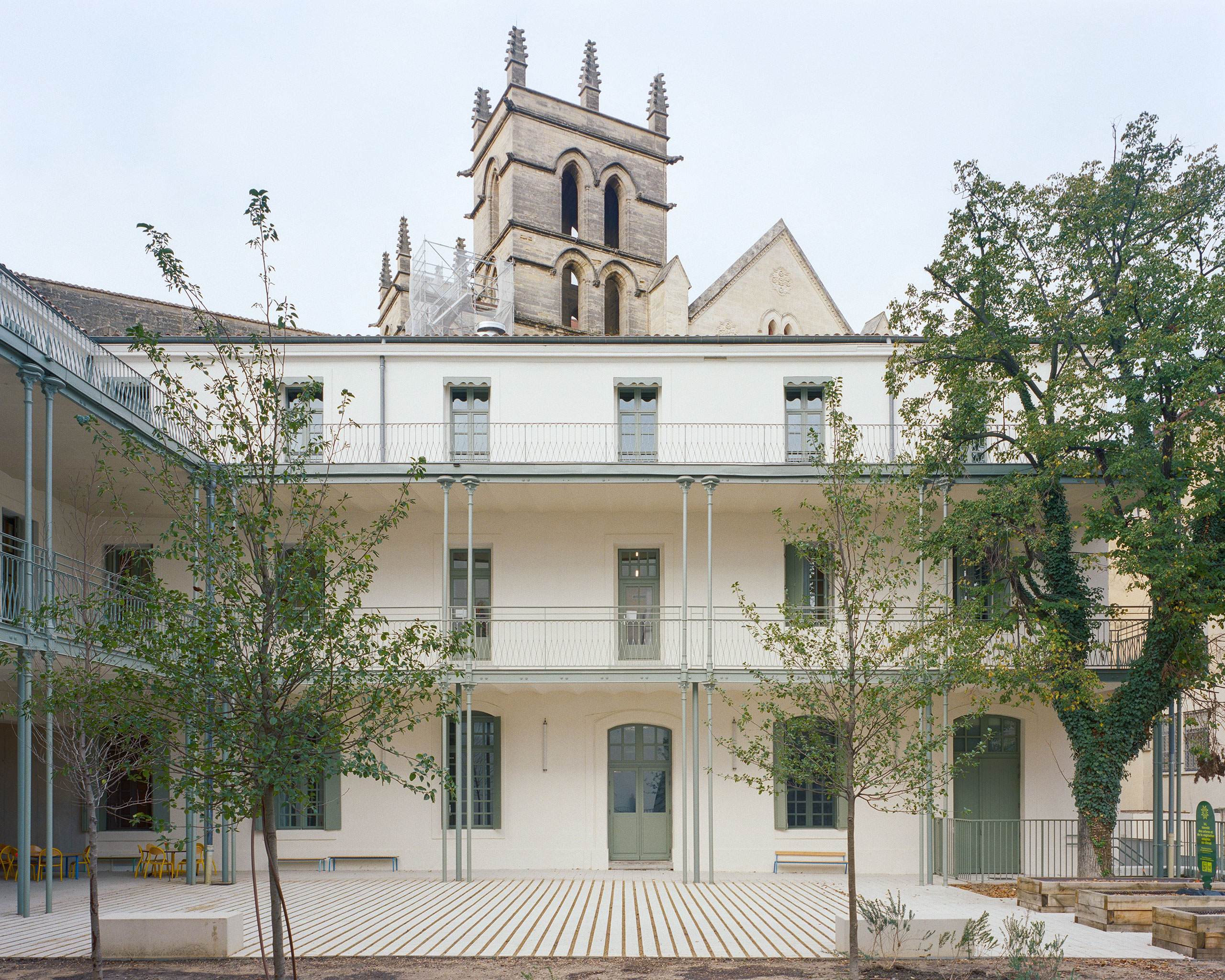
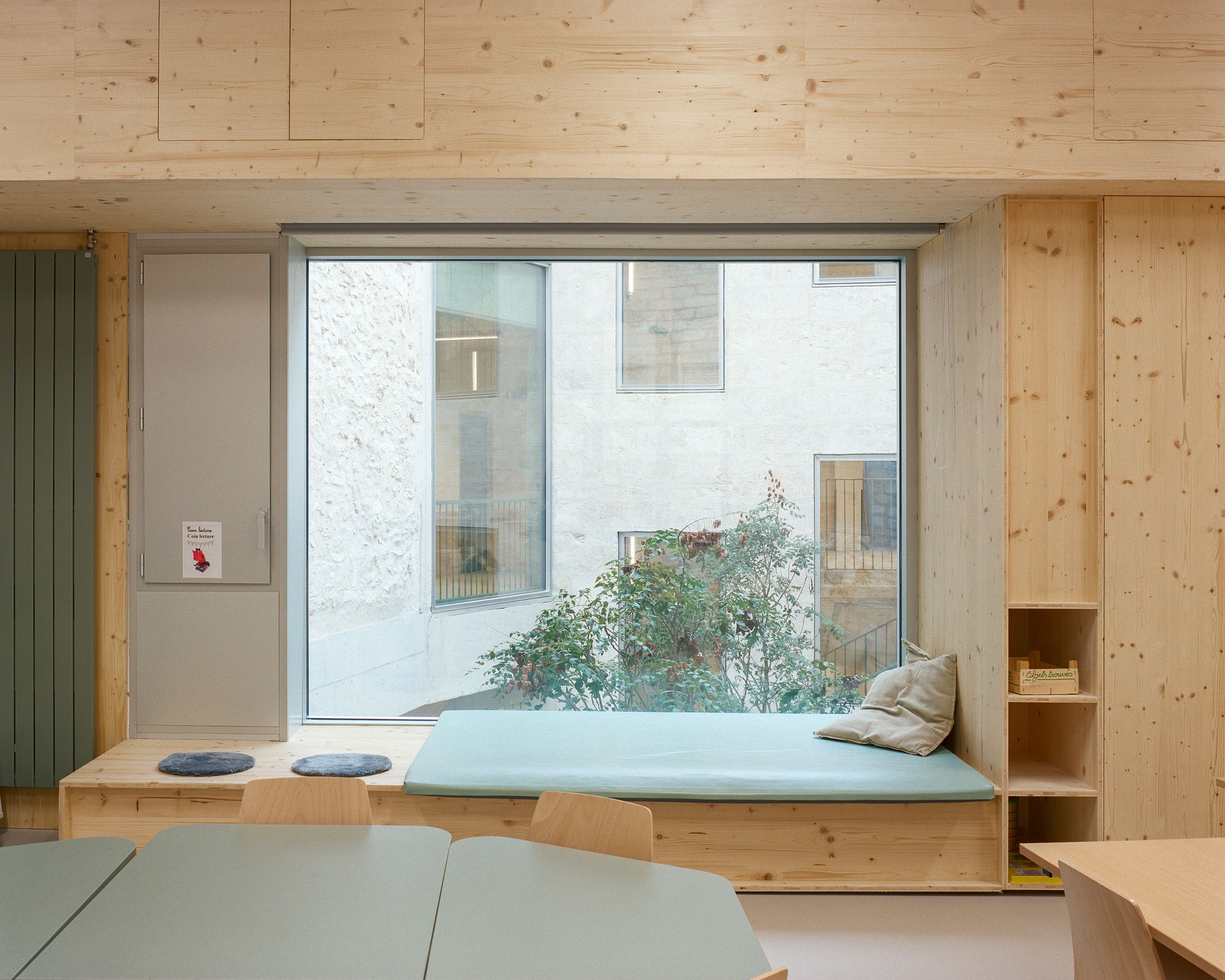
设计单位 NAS Architecture + GTA
项目地点 法国蒙彼利埃
建成时间 2025年
面积 2350平方米(室内)+1150平方米(室外)
本文英文原文由NAS Architecture提供,由有方编译。
建筑过去是蒙彼利埃音乐学院的附楼,位于Écusson历史街区中心,毗邻圣皮埃尔大教堂,具有重要的历史遗产价值。自1679年被乌苏拉会收购并设立圣查尔斯之家以来,该建筑群经历了多次改扩建,尤其在20世纪期间。本次改造的目标,是对原建筑进行全面修复,为皮埃尔与科莱特·苏拉热小学(Pierre and Colette Soulages Primary School)提供空间。
The building of the former annex of the Montpellier Music Conservatory, located in the heart of the Écusson district and in close proximity to the Saint-Pierre Cathedral, holds significant heritage value. Since it was acquired by the Ursulines in 1679 to establish the Saint-Charles House, the complex has undergone numerous modifications and substantial densification, particularly during the 20th century.Our intervention consisted of a complete rehabilitation of the building to accommodate the Pierre and Colette Soulages Primary School.

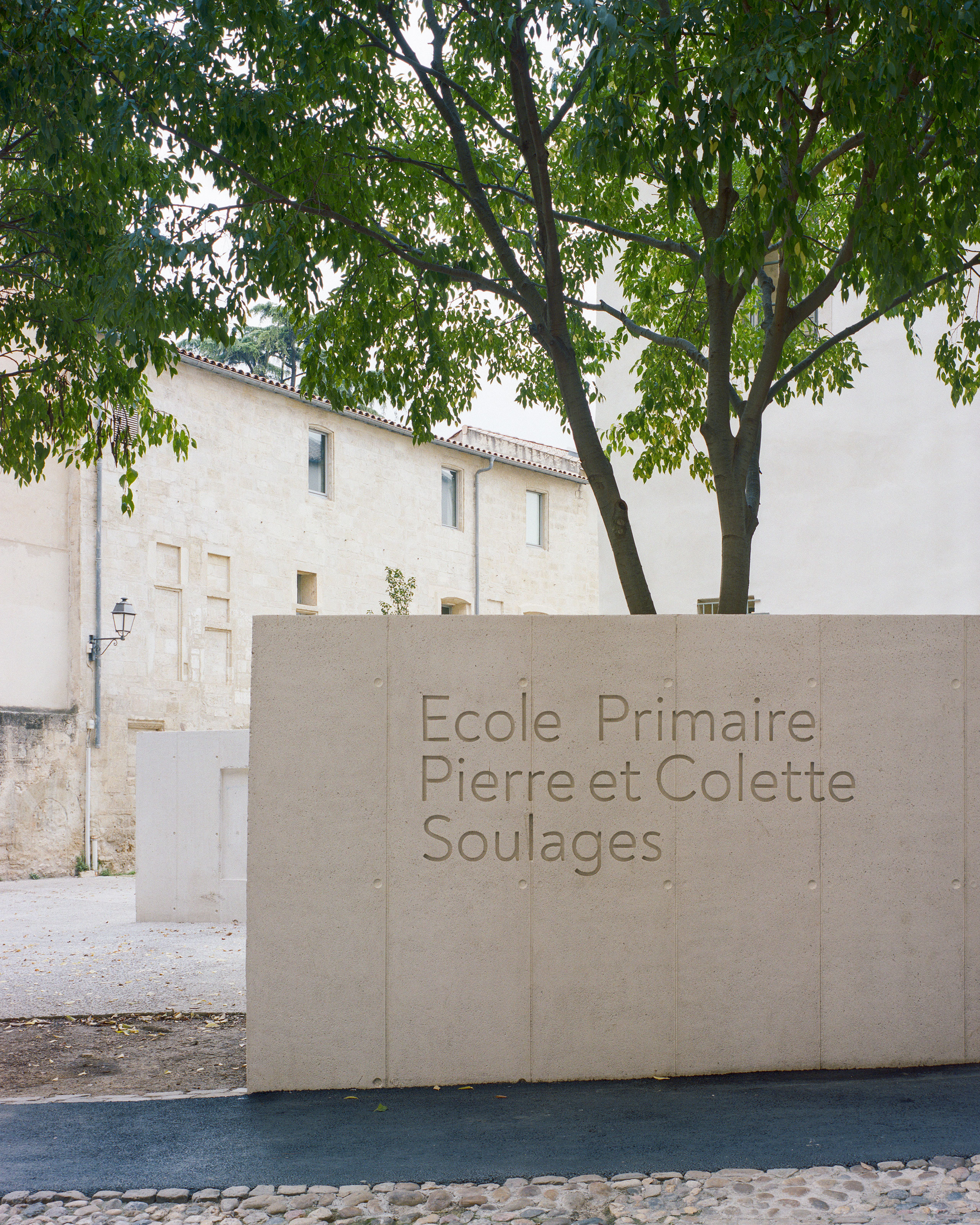

为了实现这一目标,在修复过程中我们采用了“减法”策略。通过细致的考古调研和对特色元素的识别,我们确立了设计方法:既保护和加固重要特征,又大胆进行局部拆除,以重塑场地本质。
To achieve this, we adopted a subtractive approach. Through a meticulous process of archaeological assessment and identification of remarkable elements, we developed a methodology for preserving and reinforcing key features while making bold decisions about demolitions to recover the site's essence.
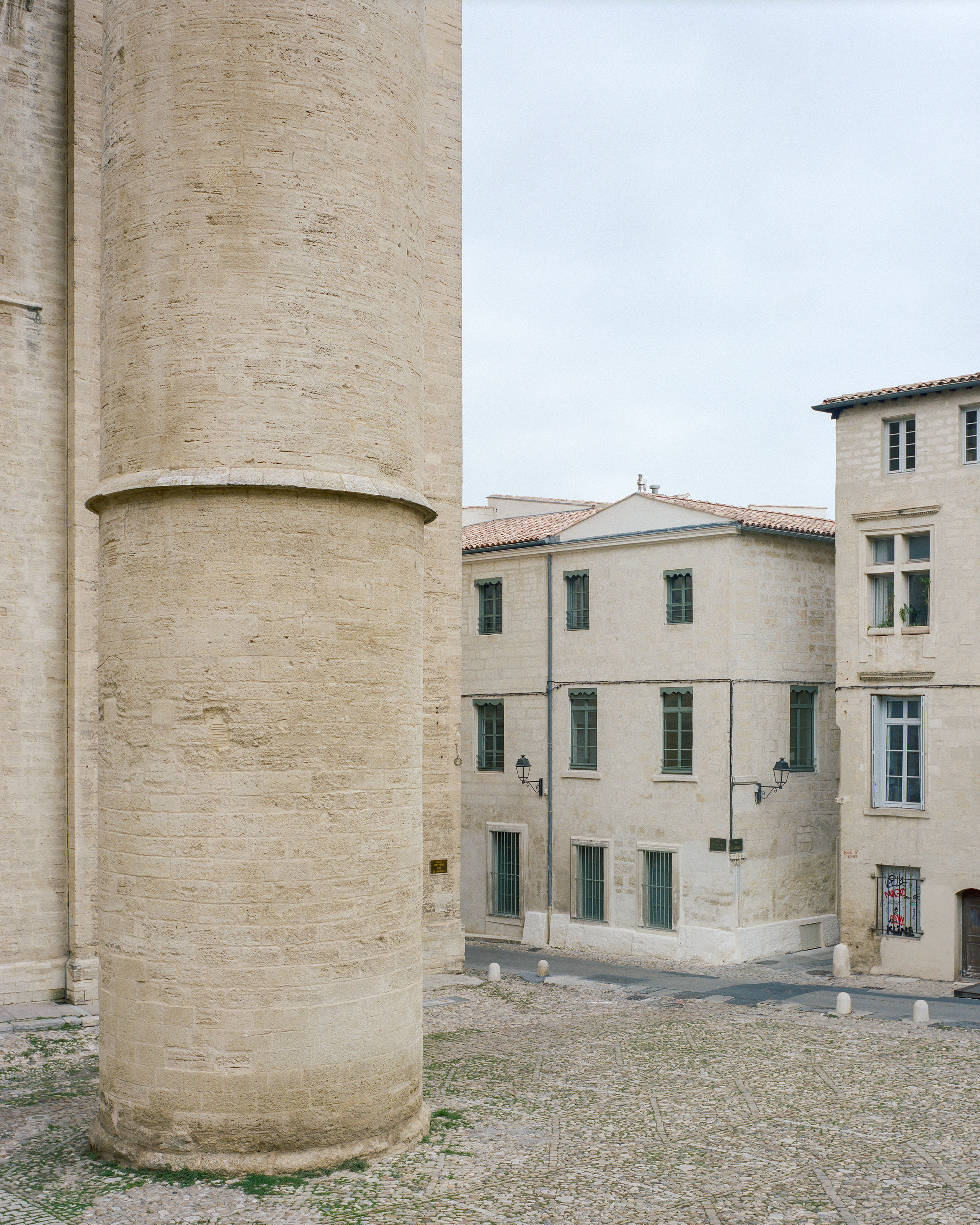
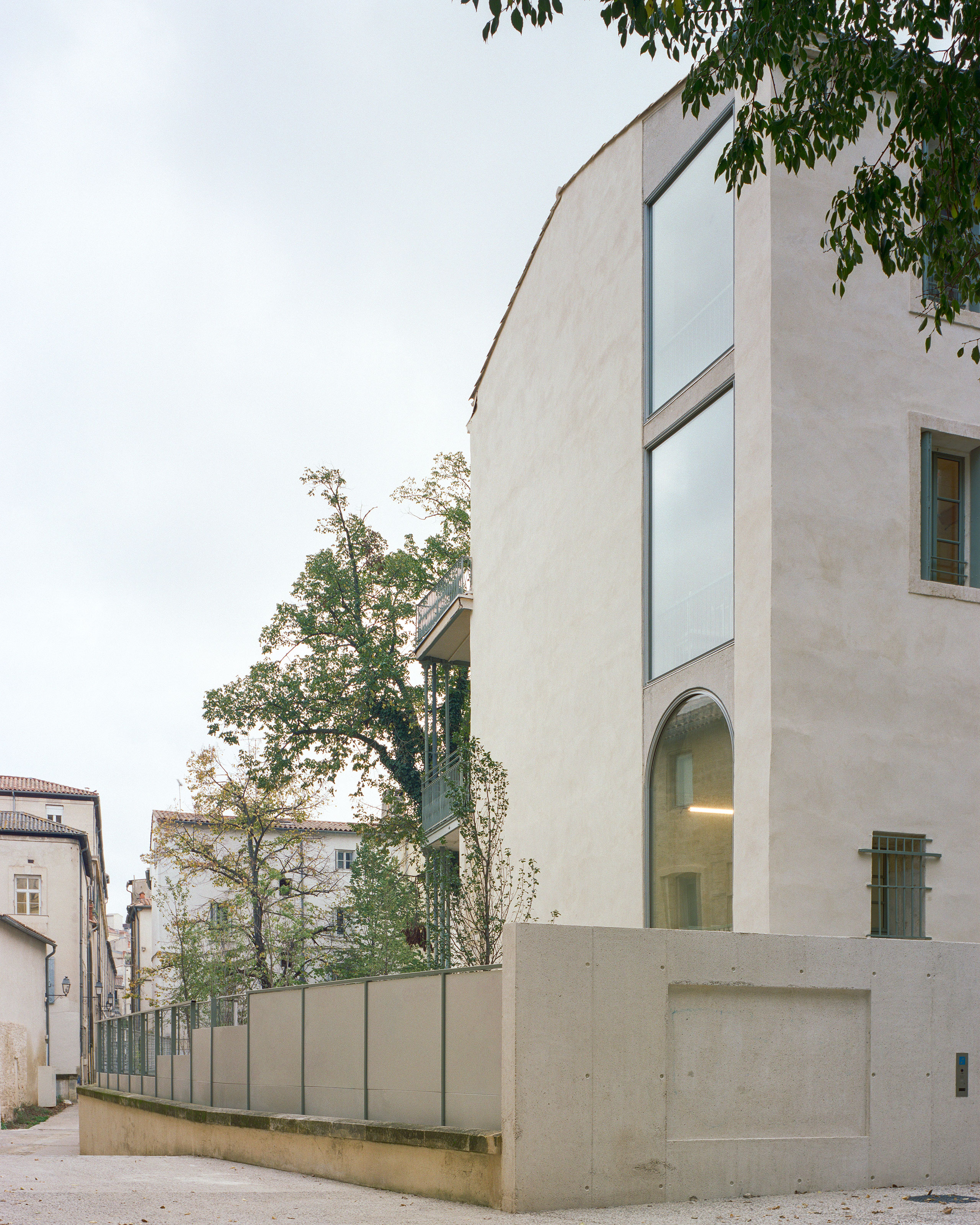
我们的设计恢复原有的空间通透性,有效降低了建筑密度,同时将自然光线引入建筑核心。全新的庭院空间揭示了布里萨克府邸(Hôtel de Brissac)原本的院落格局。小教堂部分也通过拆除1990年代新增的夹层,重新恢复了其原有空间尺度。
Restoring original porosity helped reduce density and bring natural light into the heart of the building, symbolized by a patio which reveals the original layout of the Courtyard of the Hôtel de Brissac. The chapel also regained its original volume following the removal of an intermediate floor added in the 1990s.
这项复杂且要求极高的修复工程,在普通公众使用需求与历史记忆保护之间取得了平衡,创造出一个以儿童福祉为核心的全新独特空间。
This complex and demanding rehabilitation process, balancing secular considerations and memory preservation, enabled the creation of a new, unique place where children’s well-being is valued above all.

庭院成为小学的中心空间。从主入口可以直接到达庭院,并通过一条宏伟的通道连接至操场。这一布局呼应了乌苏拉会修道院最初的平面设计:大庭院与花园相连。当时的大庭院则是今日的庭院,花园则转化为了现在的操场。
The patio becomes the central space of the Primary School. Directly accessible from the entrance, it serves as a link to the playground via a monumental passage. This gesture directly references the original plan of the Ursuline Convent, which connected the Grand Courtyard—now the patio—to the gardens, transformed into today’s playground.
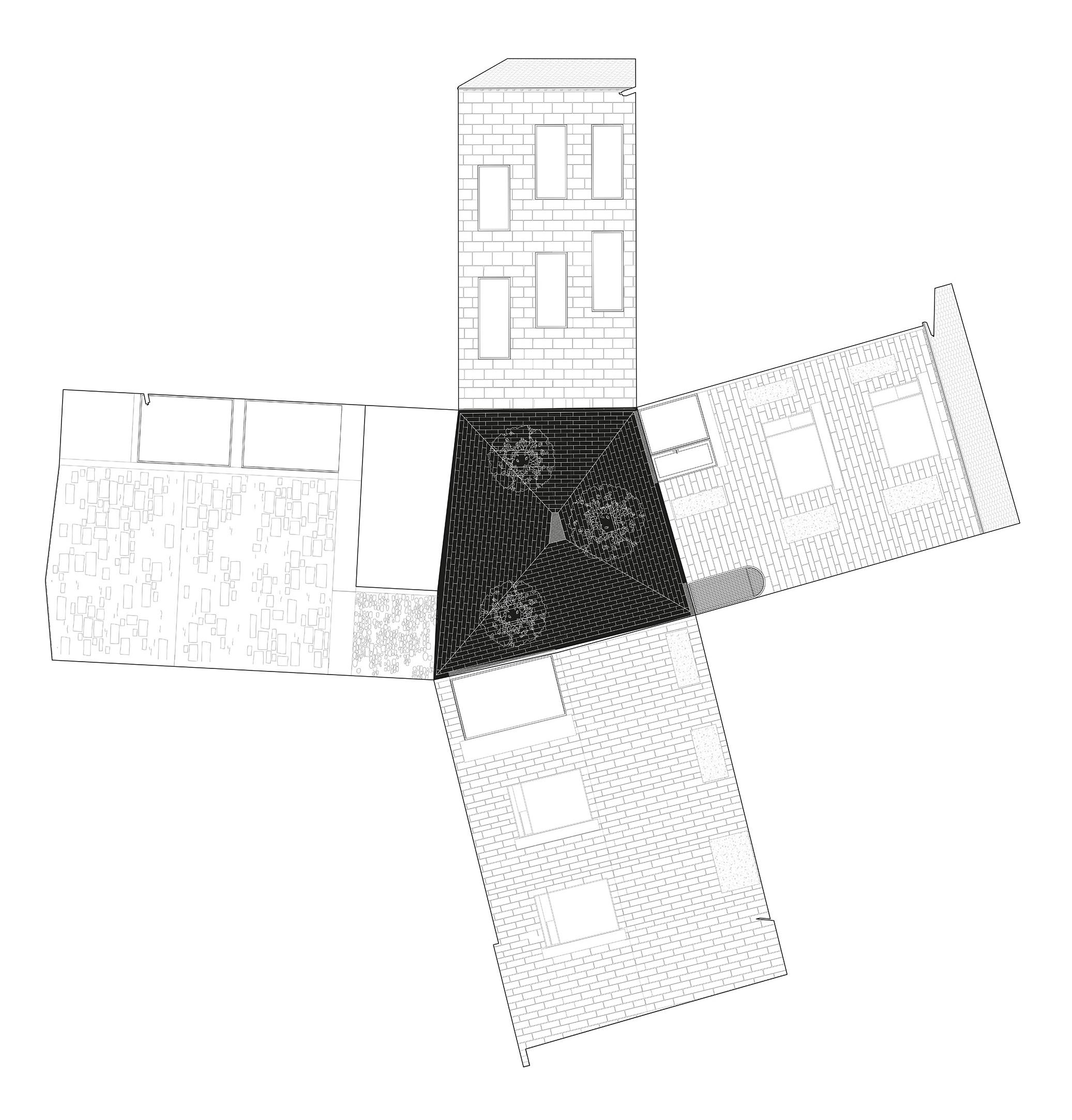
拆除20世纪加建的遮挡物后,圣查尔斯之家与布里萨克府邸的历史立面得以重见天日。裸露的石墙诉说着建筑过往的故事。大楼梯的立面重新恢复了原有的开口,重新建立起实体与空隙的节奏感,并为访客提供了眺望大教堂尖顶的新视角。诸如20世纪新开的门洞等过去增改的痕迹,被保留下来作为建筑表面的空缺印记,作为建筑演变历史的可视化记录。
Demolition of the 20th-century constructions that obstructed this area revealed the historic facades of the Saint-Charles House and the Hôtel de Brissac. Every wall surface tells a story through its exposed stonework. The grand staircase’s façade has regained its original function, with reopened historical openings that re-establish the rhythm of solid and void associated with this important access point, also offering new views of the cathedral spire. Traces of past modifications, such as 20th-century wall openings, have been preserved as hollow marks, now forming part of the vertical surfaces that narrate the building’s turbulent history and evolution.
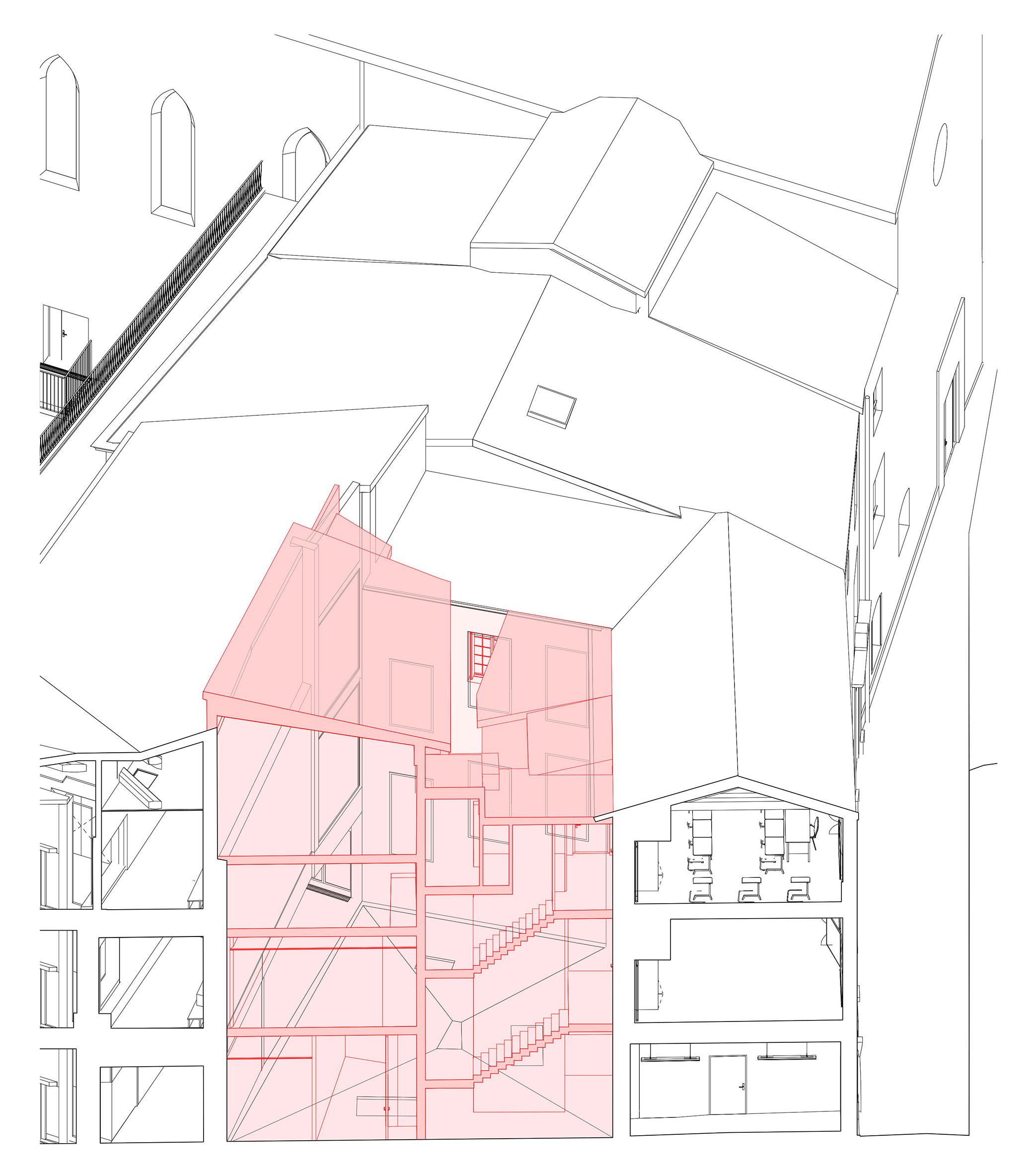
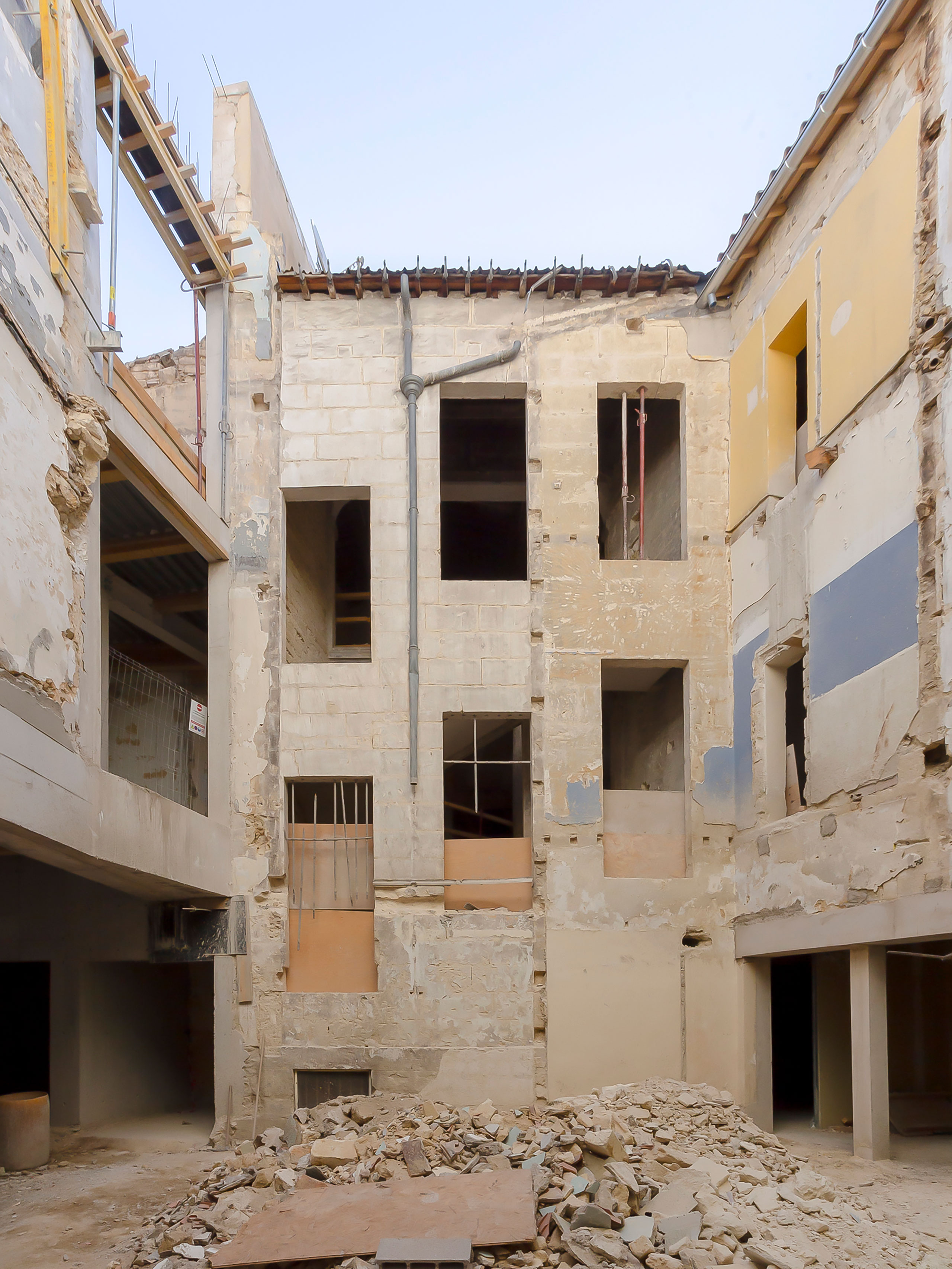


庭院还通过自然通风促进了热环境的调节,形成一个宜人的微气候。新开设的窗洞在整体空间布局中有着自己的个性,也使得各教室能够实现良好的交叉通风。
The patio also contributes to thermal regulation through natural ventilation, creating a refreshing microclimate. The new openings assert their identity within the overall space composition, allowing classrooms to benefit from cross-ventilation.
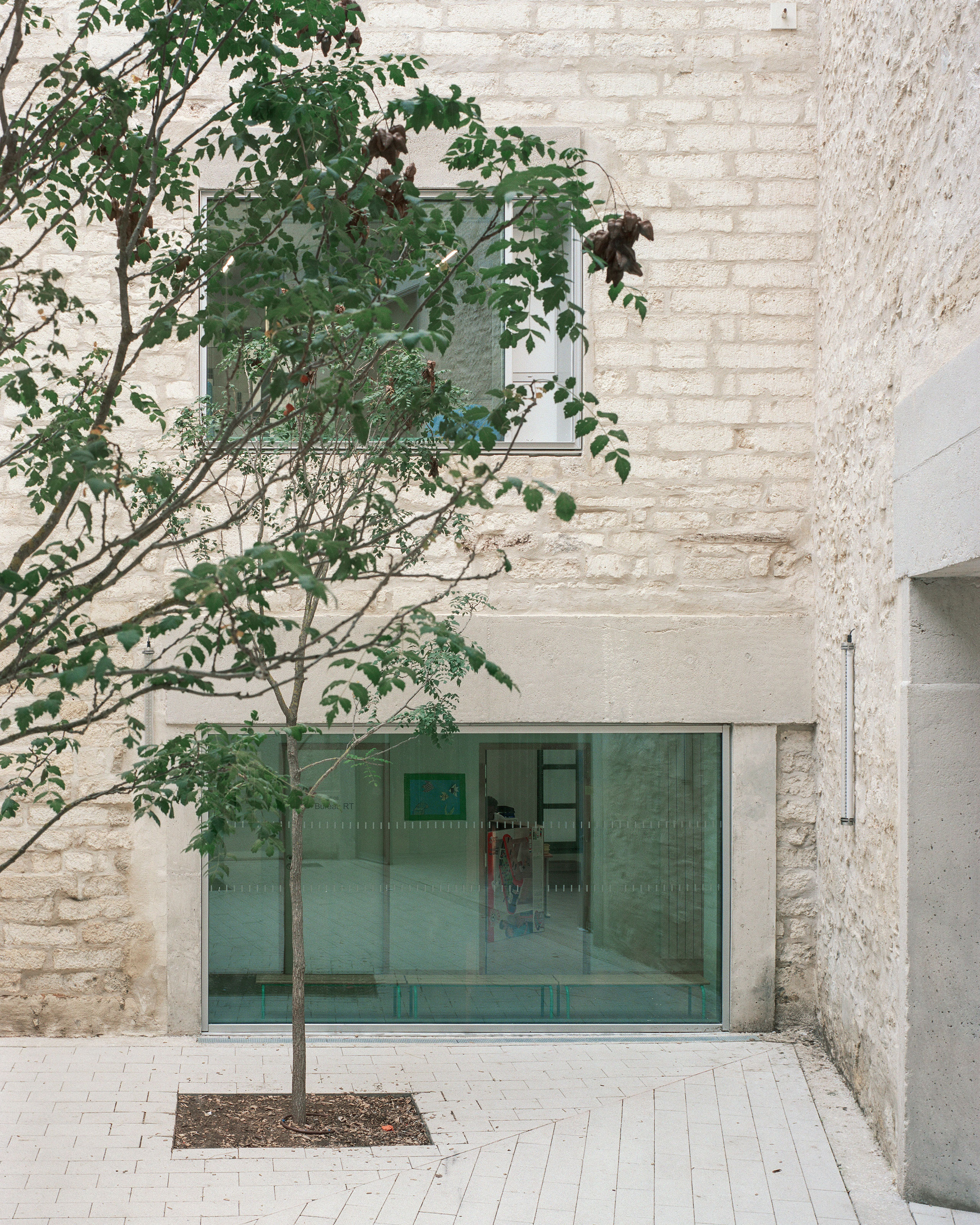
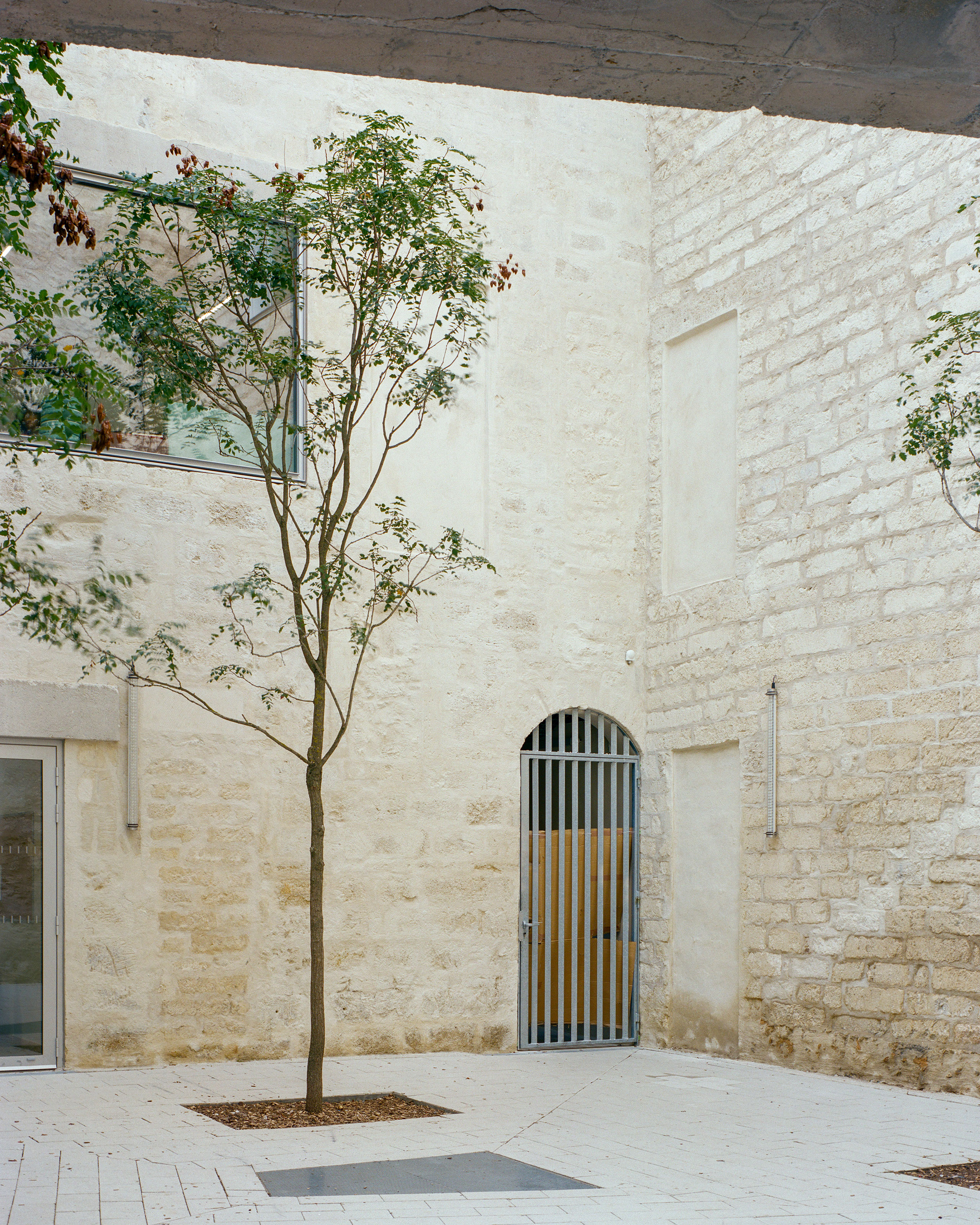
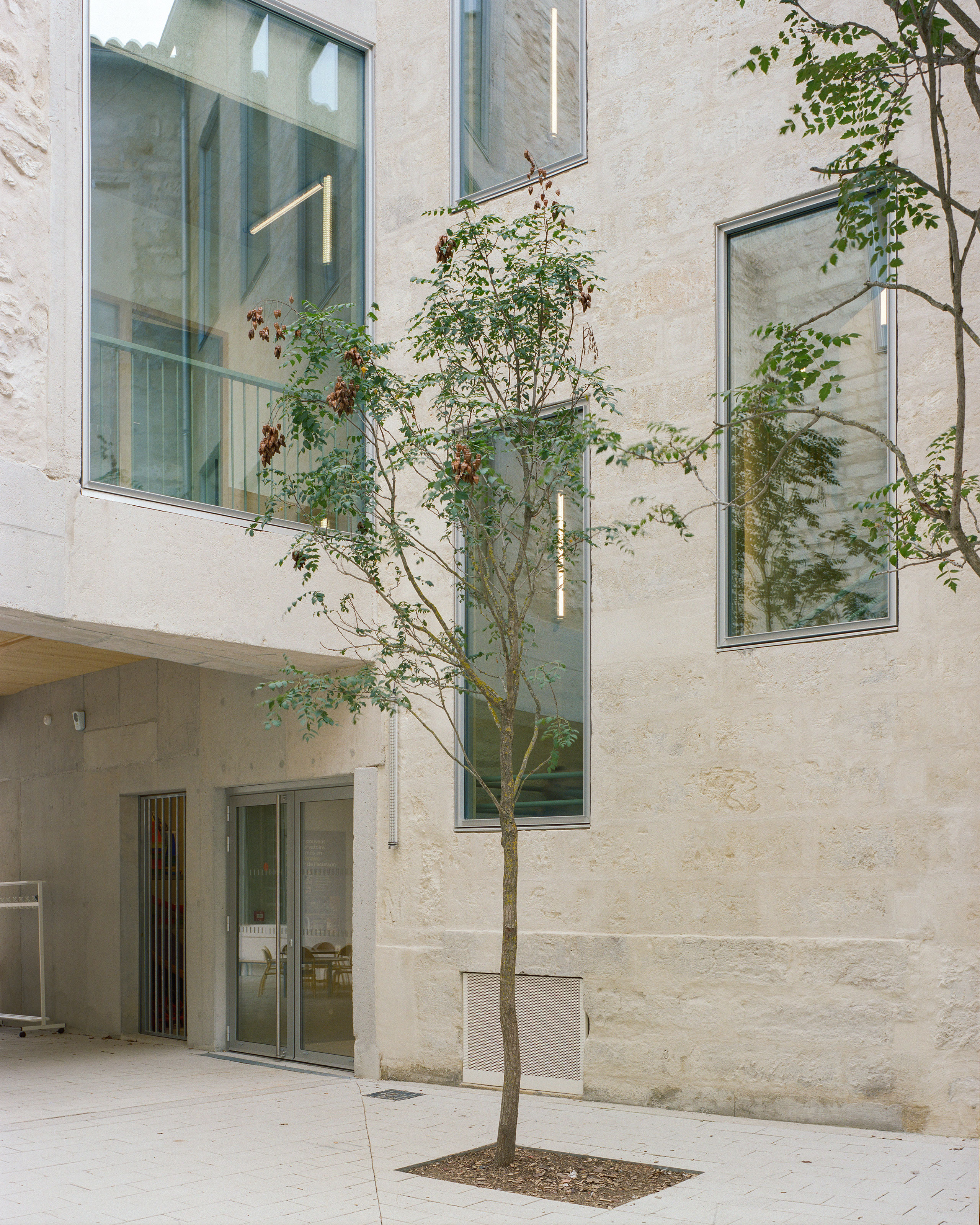
三处超大的竖向开口划分了建筑体量,清晰地标示出历史发展中的重要节点。第一处开口从学校的新入口处可见,标志着法国大革命后1792年乌尔苏拉修道院的出售,以及同期“西翼”的增建。
Three oversized vertical openings segment the building, revealing key historical junctures. The first one, visible from the school’s new entrance, marks the sale of the Ursuline convent in 1792 following the French Revolution and the simultaneous addition of the “West Wing”.
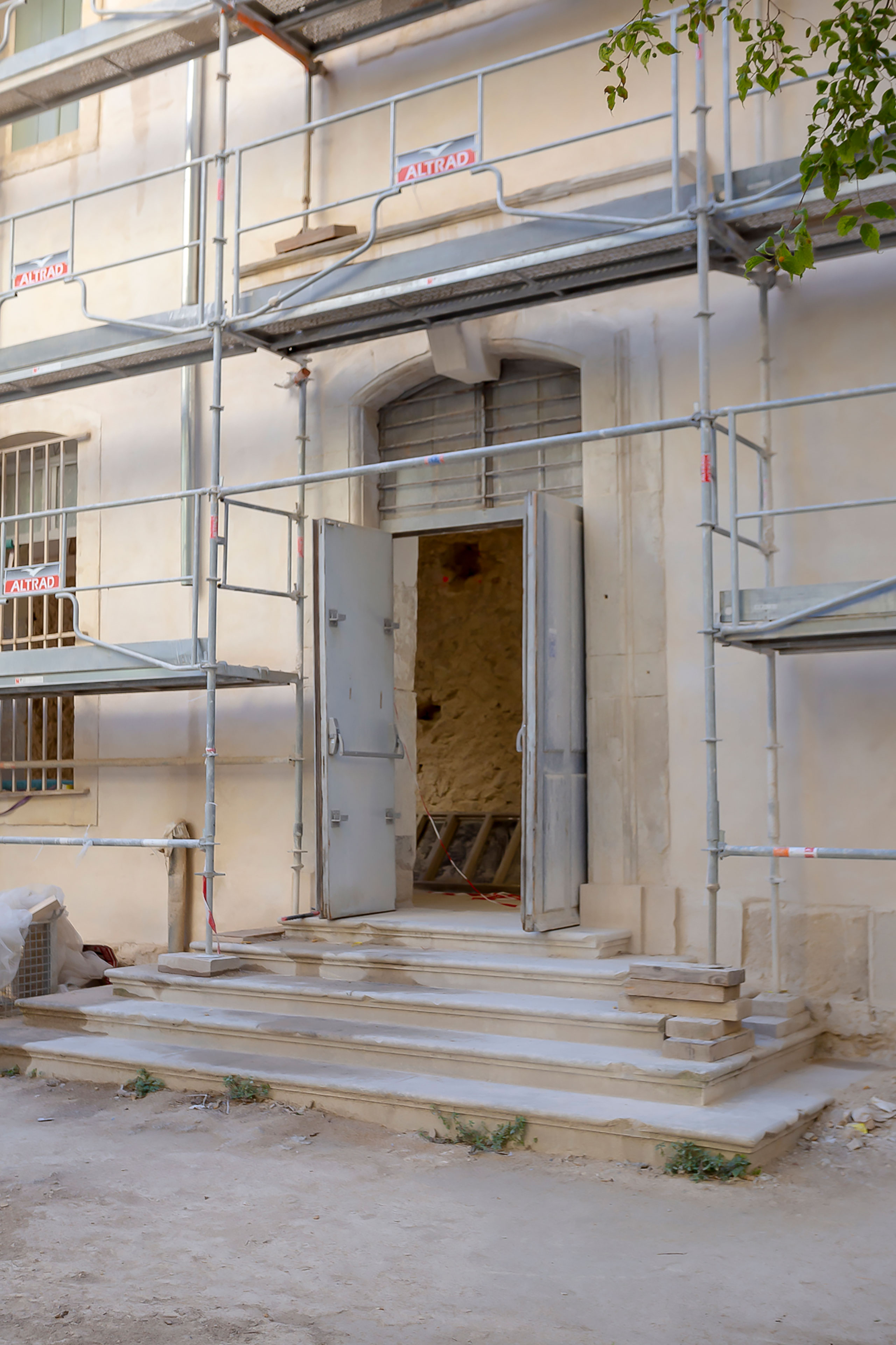
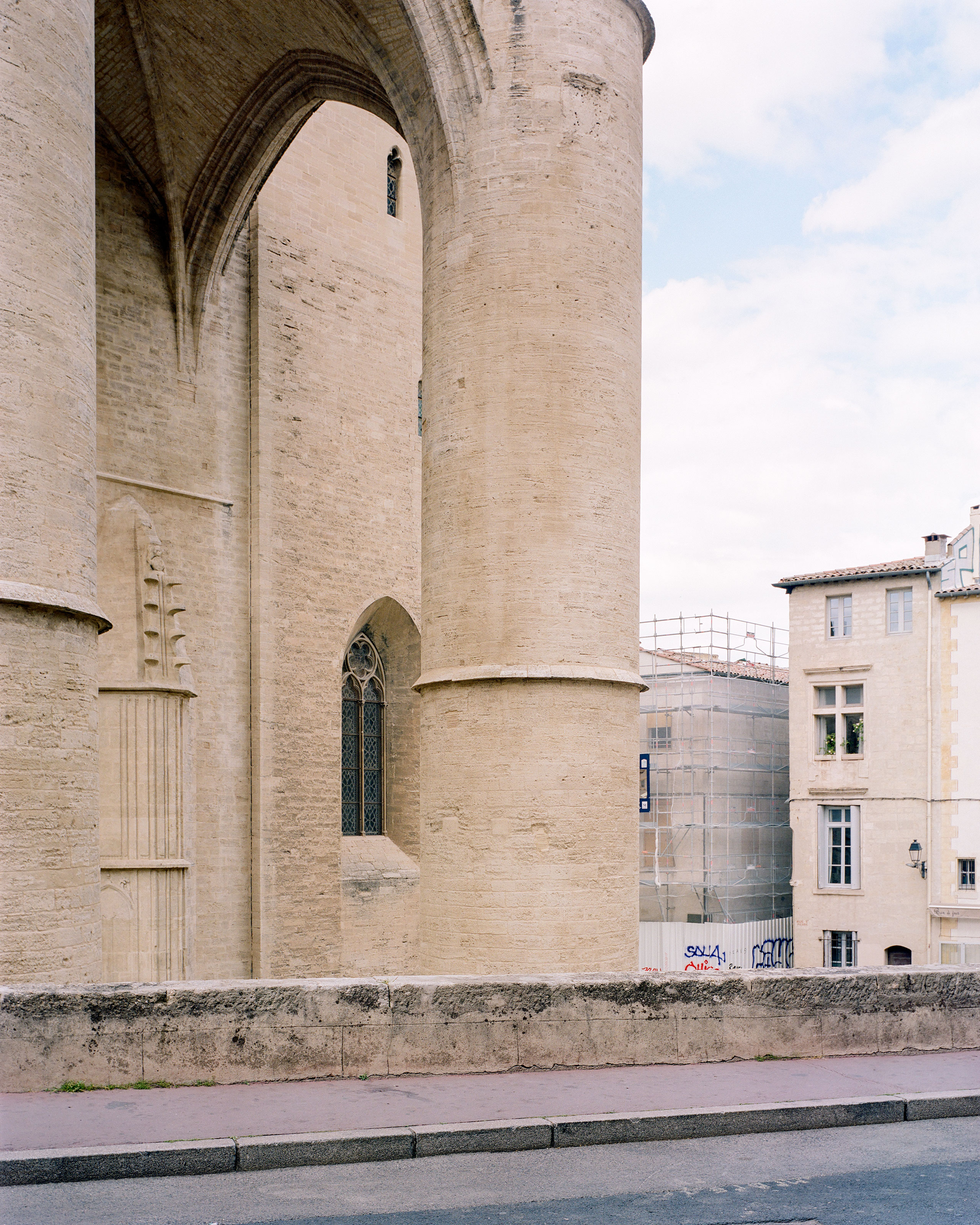
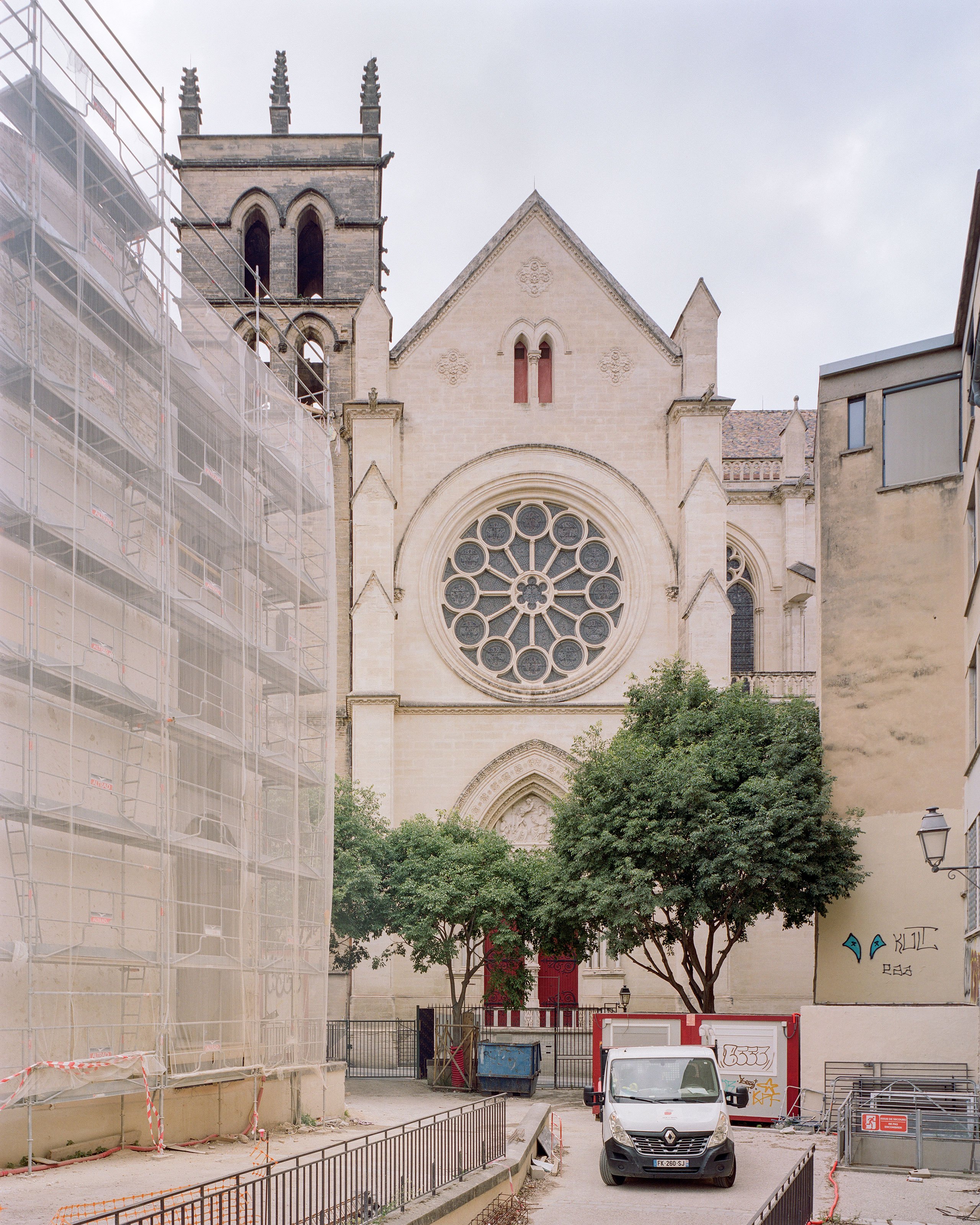
第二处开口从当前庭院可见,它展示了1857年将前布里萨克府邸与加高的西翼连通、封闭大庭院的历史时刻。第三处开口位于西翼山墙端,框景式地引导视线延伸至蒙彼利埃国家戏剧艺术学院——这座建筑曾与当前的学校相连。1990年代的拆除行动破坏了原有的城市肌理,如今只有这些大型开口标志着它们的历史。
The second one, visible in the current patio, highlights the 1857 connection between the former Hôtel de Brissac and the raised West Wing, enclosing the convent’s Grand Courtyard.The third void, at the gable end of the West Wing, frame the gallery while directing the gaze towards the National School of Dramatic Arts of Montpellier, which was once connected to the current building. Demolitions in the 1990s erased the historical urban fabric—now only signified by these large openings.
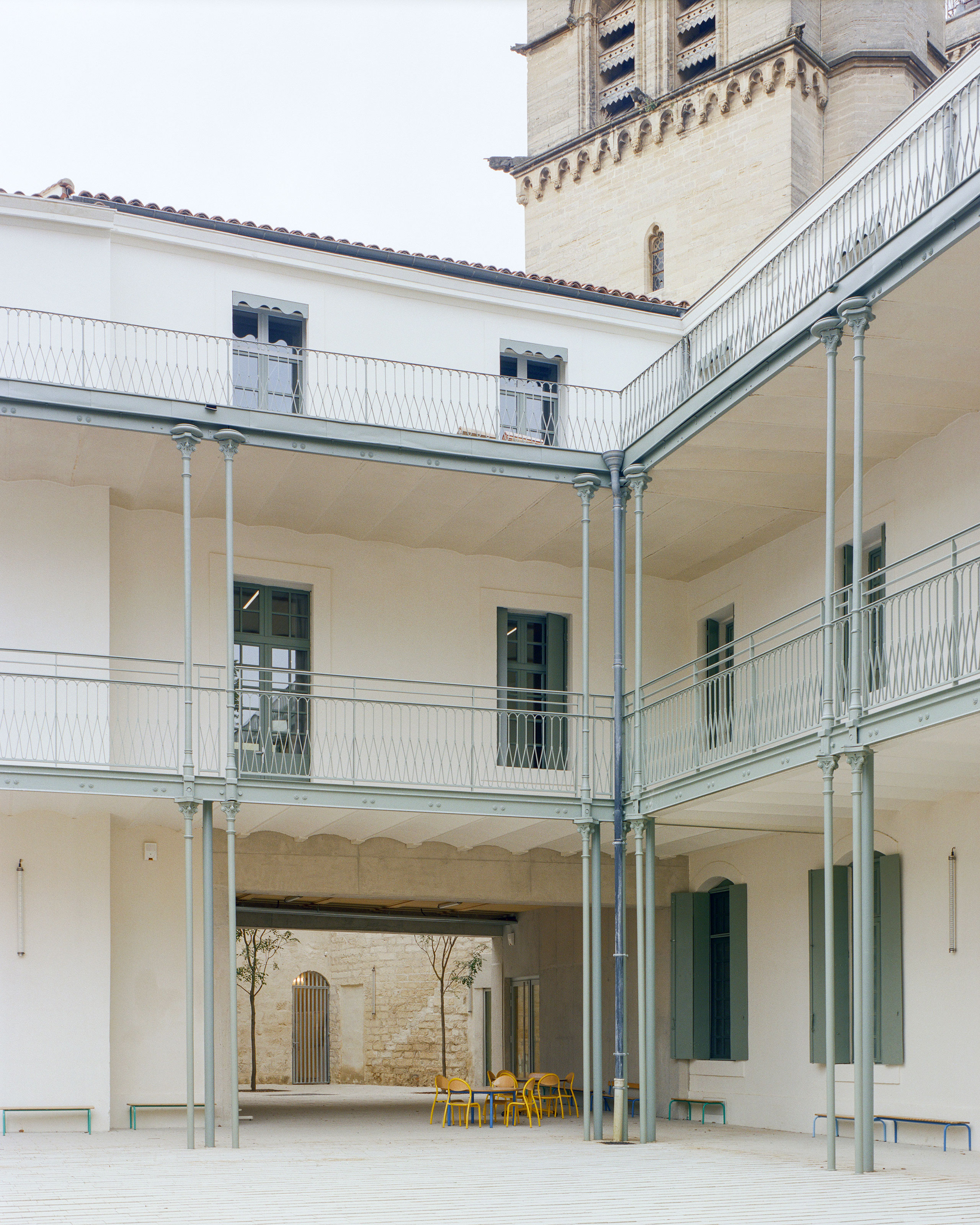
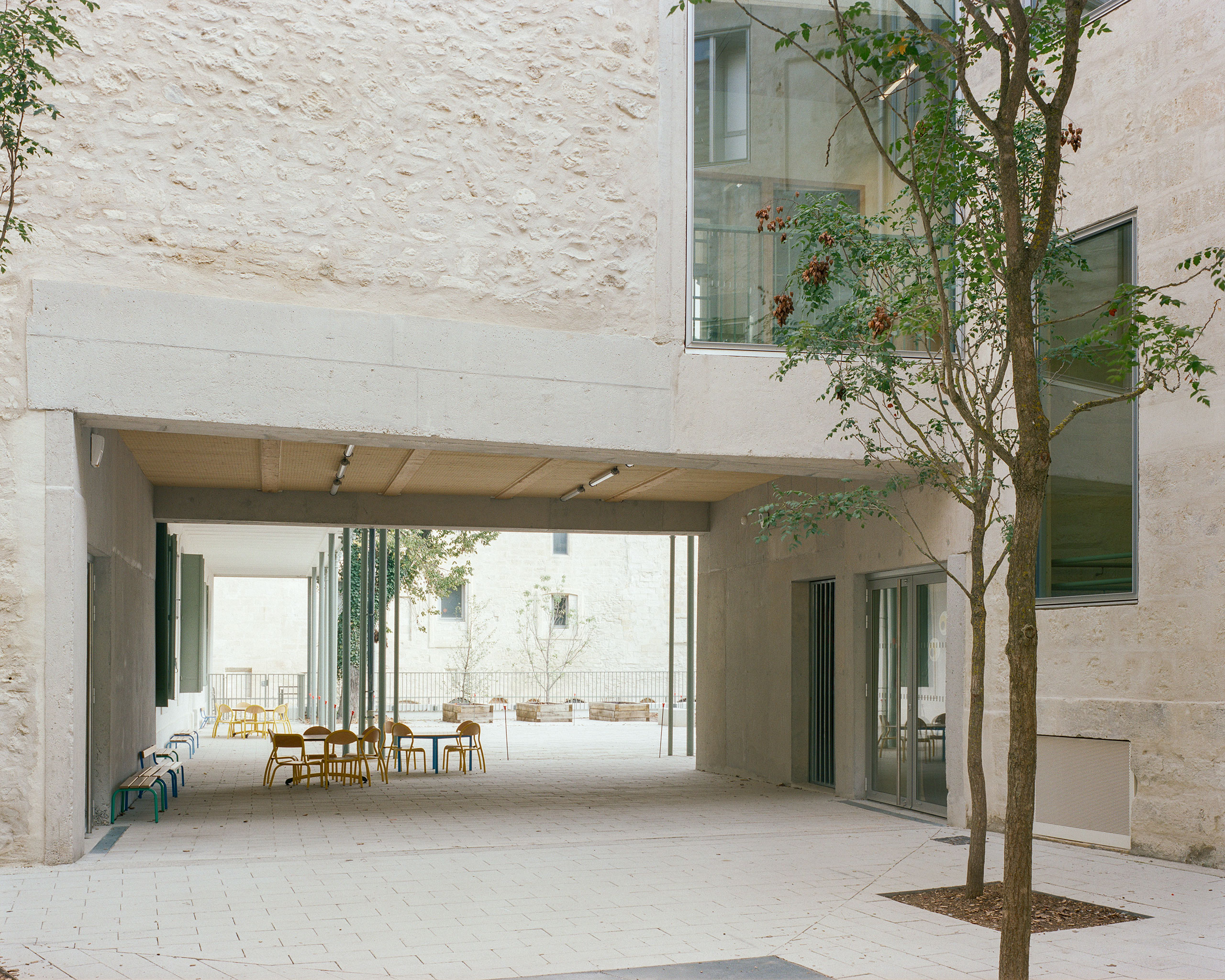
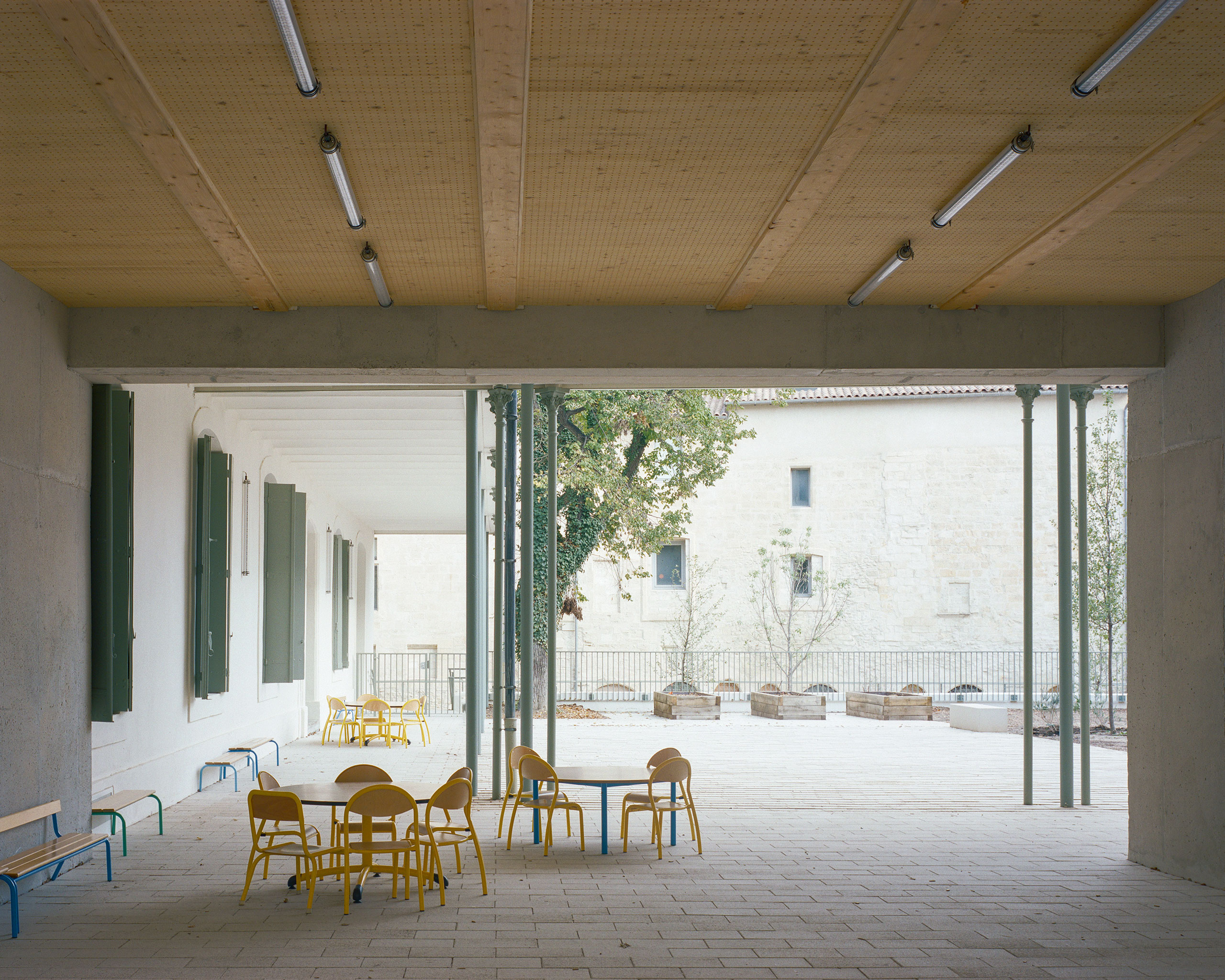
大尺寸的铝框窗户为校园各处引入充足自然光,同时带来全新的蒙彼利埃历史城市中心视角。
Large-scale aluminium-framed windows provide generous natural light throughout the school while offering new perspectives on Montpellier’s historic city center.
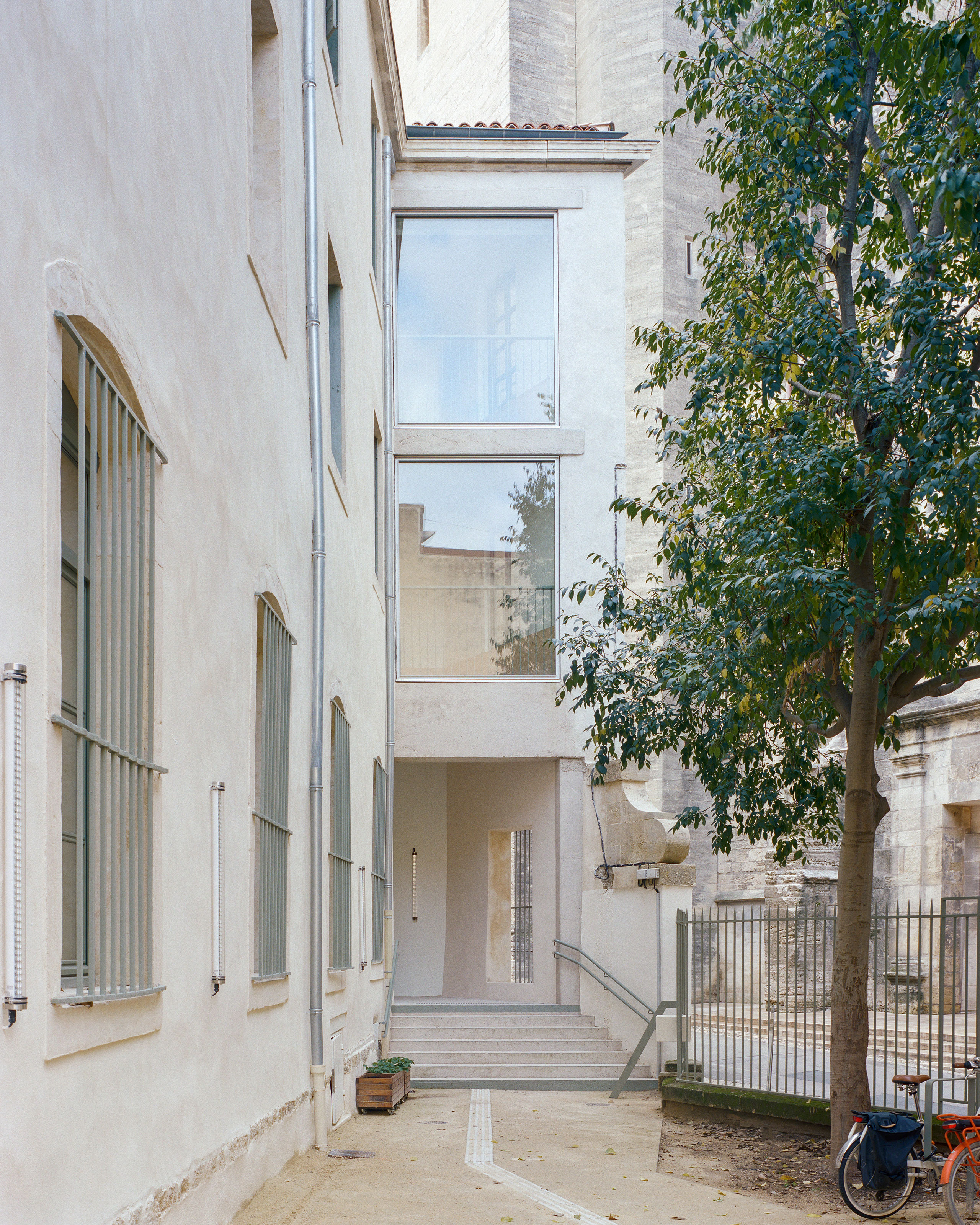
小教堂作为场地历史的重要标志,具有特殊意义。1857年,它由建筑师Nulma Polge以新哥特式风格建造,但在1990年代曾被大幅改动,当时加建了混凝土夹层,将原本完整的空间分隔成两个音乐学院用的表演厅。此次改造的主要目标,是通过拆除这一中间楼层,恢复教堂原有的空间体量。
The chapel is a powerful marker of the site’s history. Built in 1857 by architect Nulma Polge in a neo-Gothic style, it was heavily altered in the 1990s with the addition of a concrete mezzanine dividing the building into two performance spaces for the Conservatory. The main goal of the rehabilitation was to restore the original volume by removing this intermediate floor.
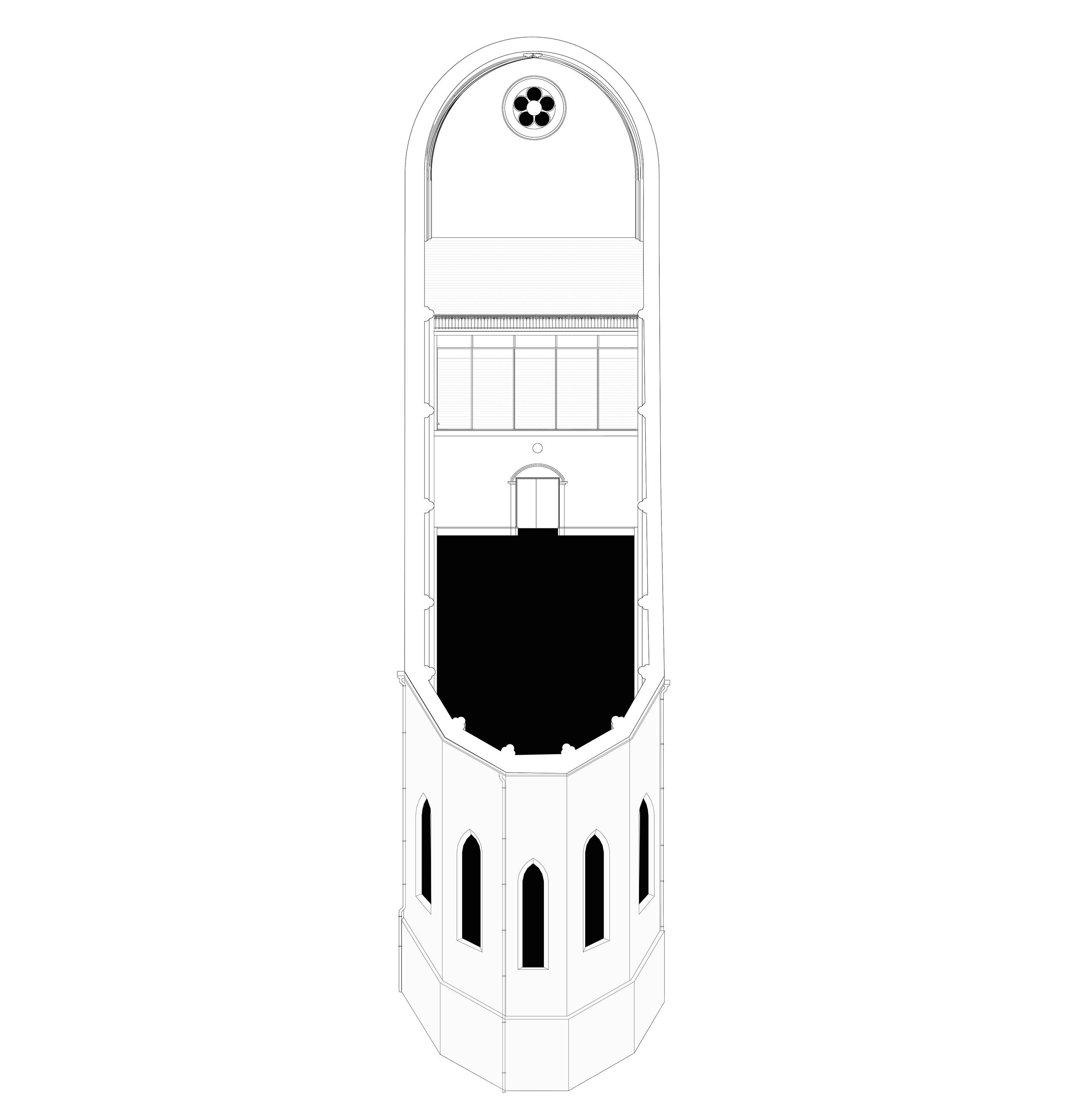
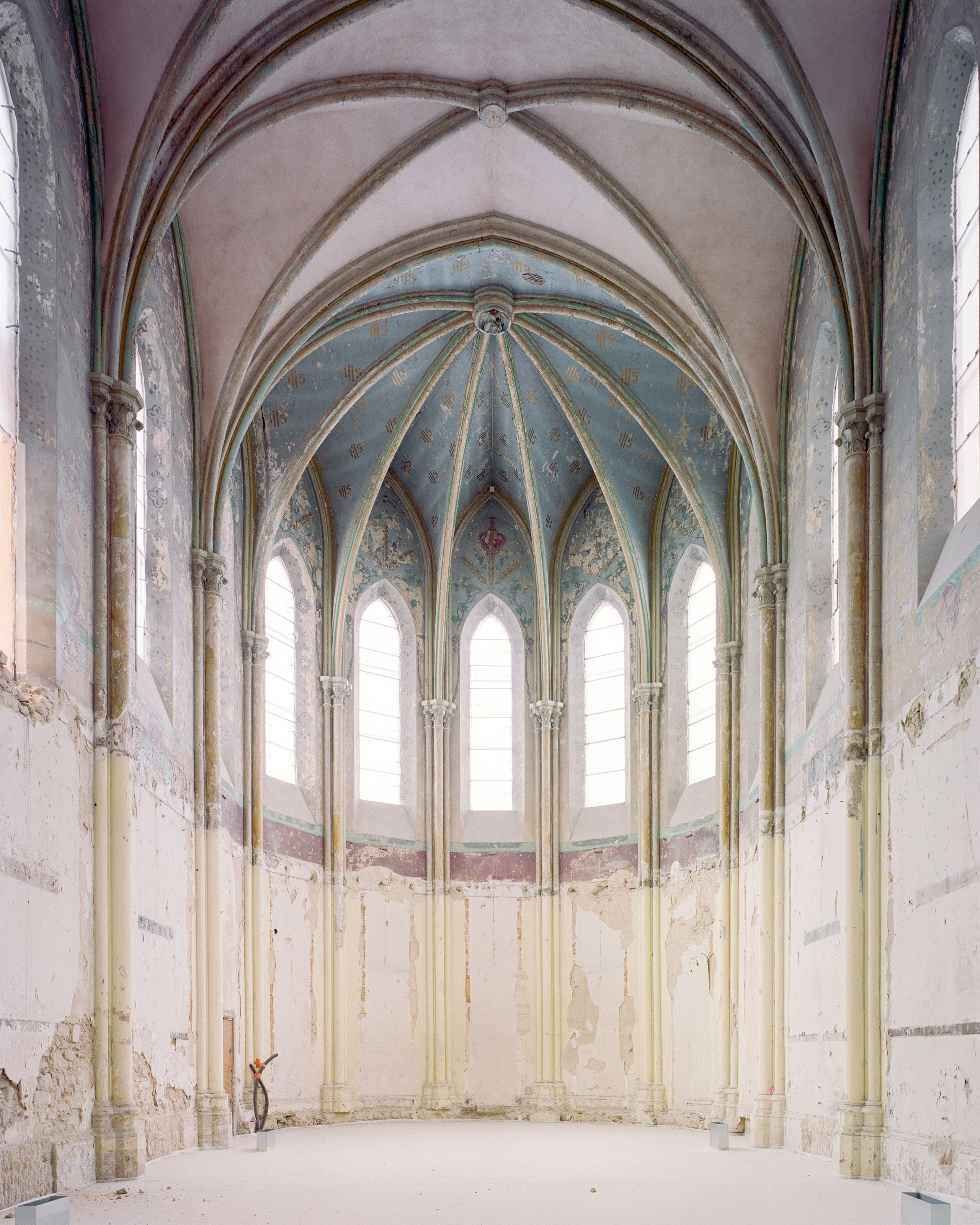
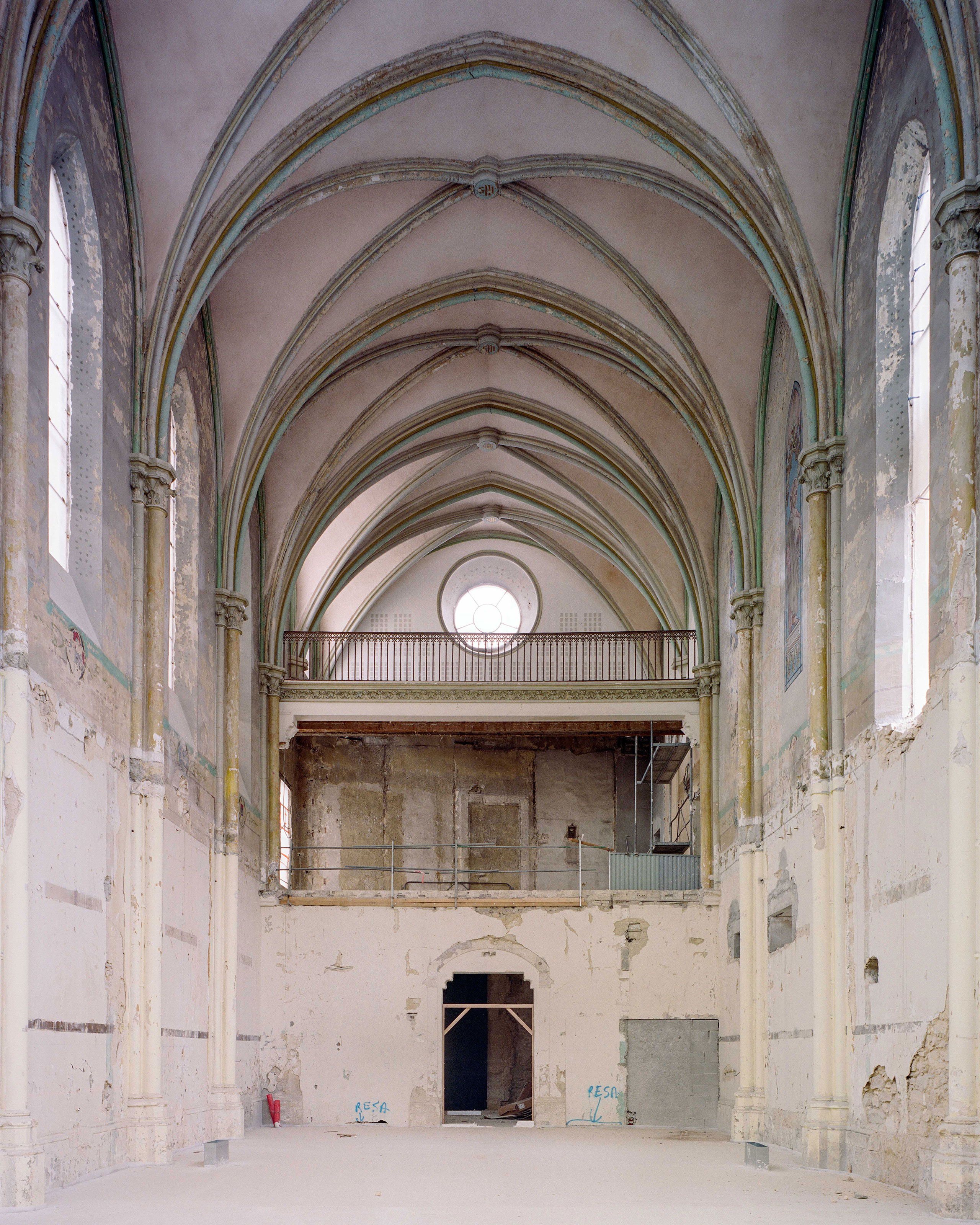
拆除后,整个空间以统一的方式处理,采用涂有石灰的无纺布覆盖,以在不破坏原有装饰的前提下统一受损墙面——尽管其中很多装饰元素本身是年代不明的仿作。所有彩色玻璃花窗也被仔细拆除,按照传统工艺修复后重新安装。
Once removed, the entire space was treated uniformly with a lime-coated non-woven fabric to unify the deteriorated walls without damaging the decor, though many elements were pastiches of uncertain age. All stained glass windows were carefully removed, restored using traditional methods, and reinstalled.


添加的当代的元素以一种低调的方式存在,避免破坏原有的建筑体量。供暖与通风系统被整合进地板,声学和照明则通过独立的金属框架及张拉面料处理,为每一个空间赋予了新的韵律。建筑整体呈现出一种既有力度又十分克制的介入方式,通过尊重遗产的视角,回应了公共学校所需的世俗性要求。设计将这座原本的小教堂转变为一个多功能活动空间,直面了一座前修道院如今成为公立学校的矛盾性。
Contemporary additions are present but discreet, avoiding interference with the historic massing. Heating and ventilation systems were integrated into the floor, while acoustics and lighting were handled via freestanding metal frames with stretched fabric, adding rhythm to each bay. The result is a strong yet measured intervention, where secularism is addressed through the lens of heritage respect, turning the former chapel into a multipurpose activity room, acknowledging the paradox of a public school housed in a former convent.
19世纪80年代左右,靠近花园一侧增建了带有铸铁柱、砖拱顶和金属梁地板的连廊。这些走廊提供了遮阳和避雨的空间,为一楼的教室带来了宽敞的户外延伸区域。由于存在多种结构、消防安全和无障碍方面的问题,需要进行全面加固后对公众开放。如今,这些区域已经成为功能完善的室外学习空间,良好地适应蒙彼利埃的地中海气候特点。
Around the 1880s, garden-side galleries were built with cast-iron columns, brick vaulting, and metal-beamed floors. These walkways provide shade and shelter, offering large outdoor extensions connected directly to the first-floor classrooms. Due to various structural, fire safety, and accessibility issues, comprehensive reinforcement work was necessary to open these areas to public use. These now-functional spaces offer shaded outdoor study areas—perfect for Montpellier’s Mediterranean climate.
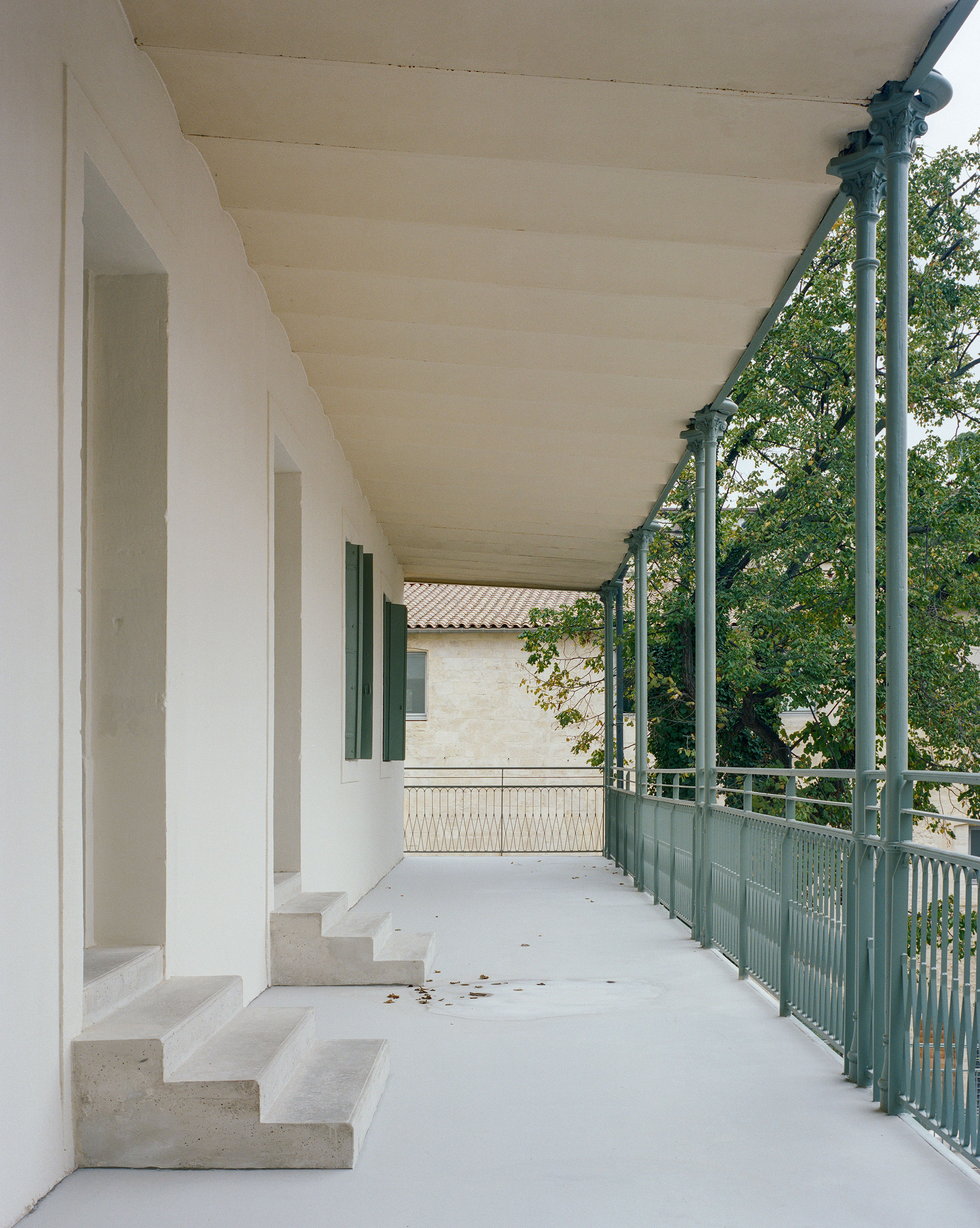
操场被划分成了两个不同的层次。中庭的鹅卵石延伸至了上层操场,间距逐渐加大以促进植物生长。下层庭院则采用完全透水的木屑铺面,周围新种植了约十棵树木。随着时间推移,这里将逐渐形成一片小型城市森林,让孩子们与自然直接亲近。
The playground is divided into two different levels. The patio’s cobblestones extend into the upper playground, becoming more spaced out to encourage vegetation growth. The lower courtyard is fully permeable with a wood chip surface and around ten newly planted trees. Over time, it will develop into a small urban forest, nurturing a direct connection to nature.
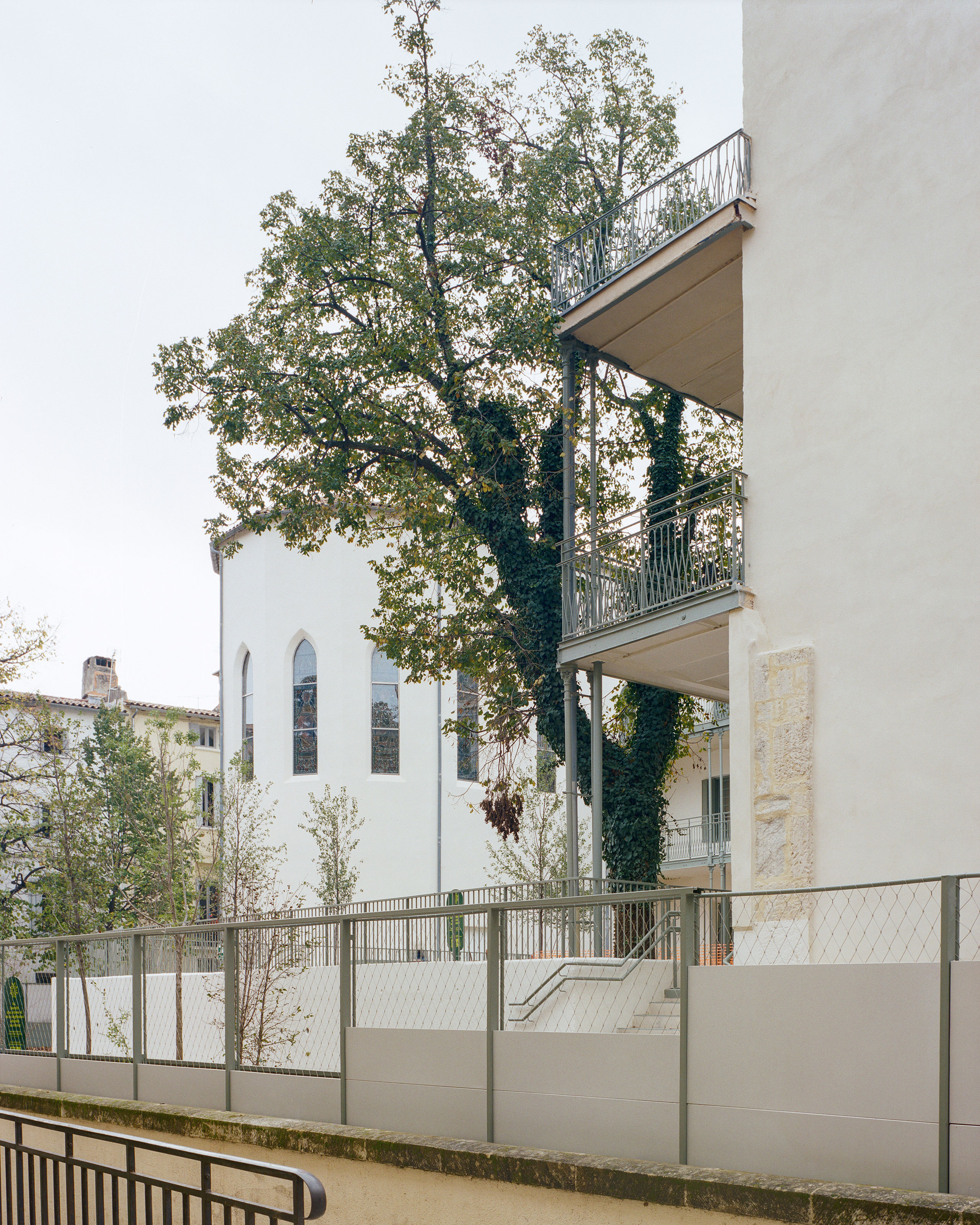
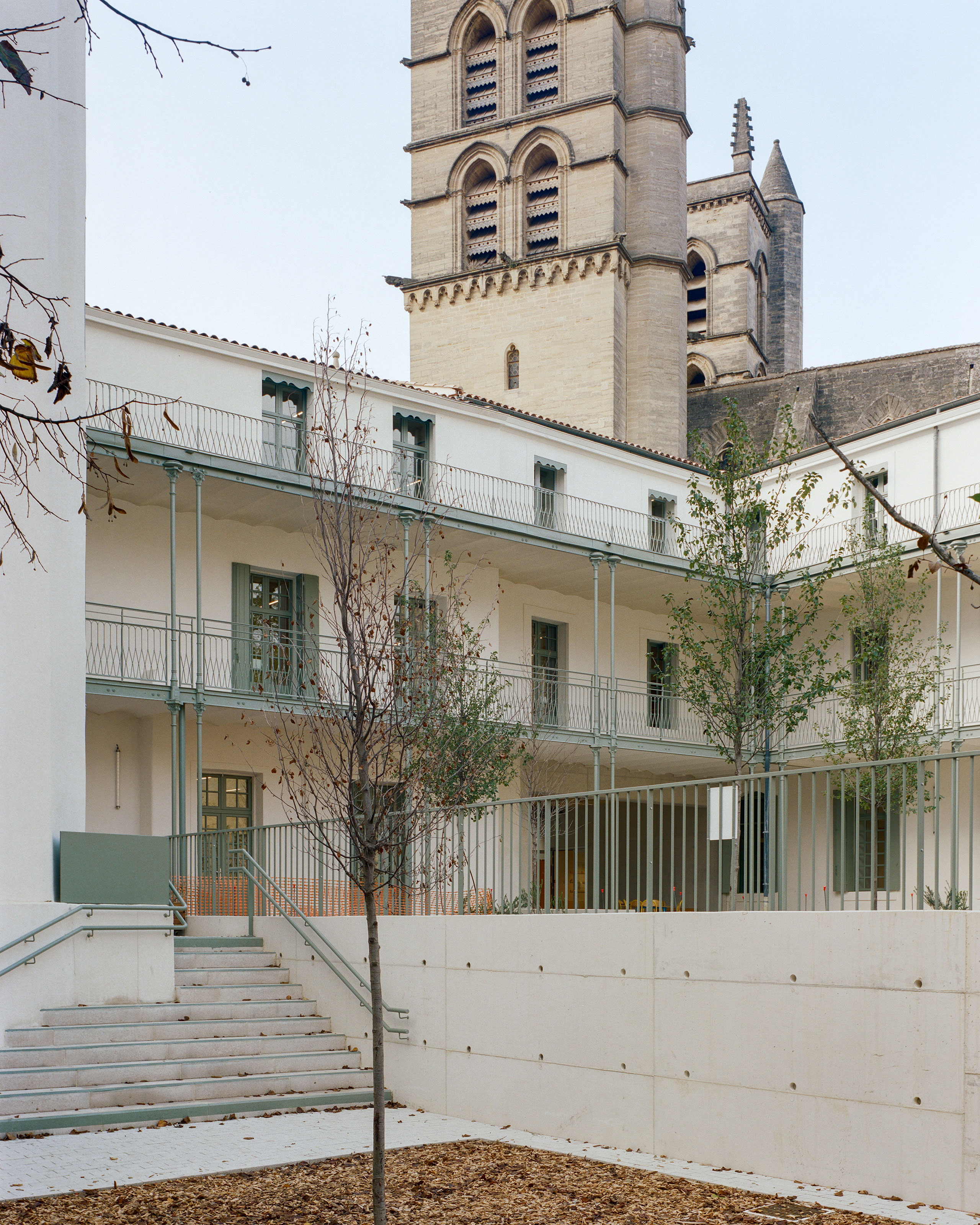
建筑室内空间的处理保持了克制和简洁。石墙堆积的覆盖层被剥离,露出精细砌筑的石作,展现出建筑曾经的功能特征。学习空间用混凝土材料向交通空间打开,混凝土保持原始喷砂处理,成为空间新身份的一部分。
The interior spaces were treated with restraint and simplicity. Stone walls were stripped of accumulated layers, revealing finely laid masonry that reflects former architectural functions. Concrete was chosen for its ability to open learning spaces toward circulation areas. Left raw and sandblasted, it now shapes part of the spatial identity.
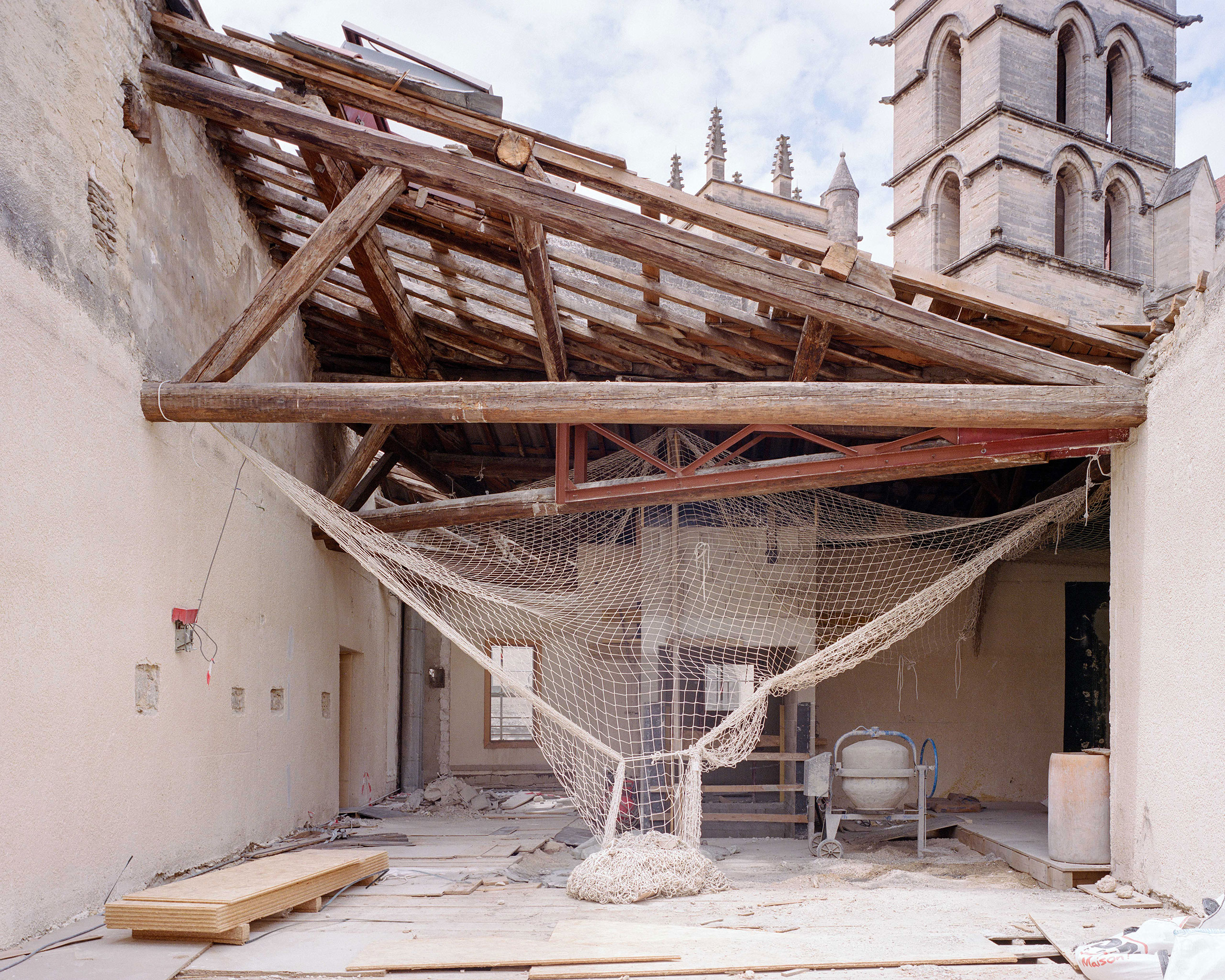
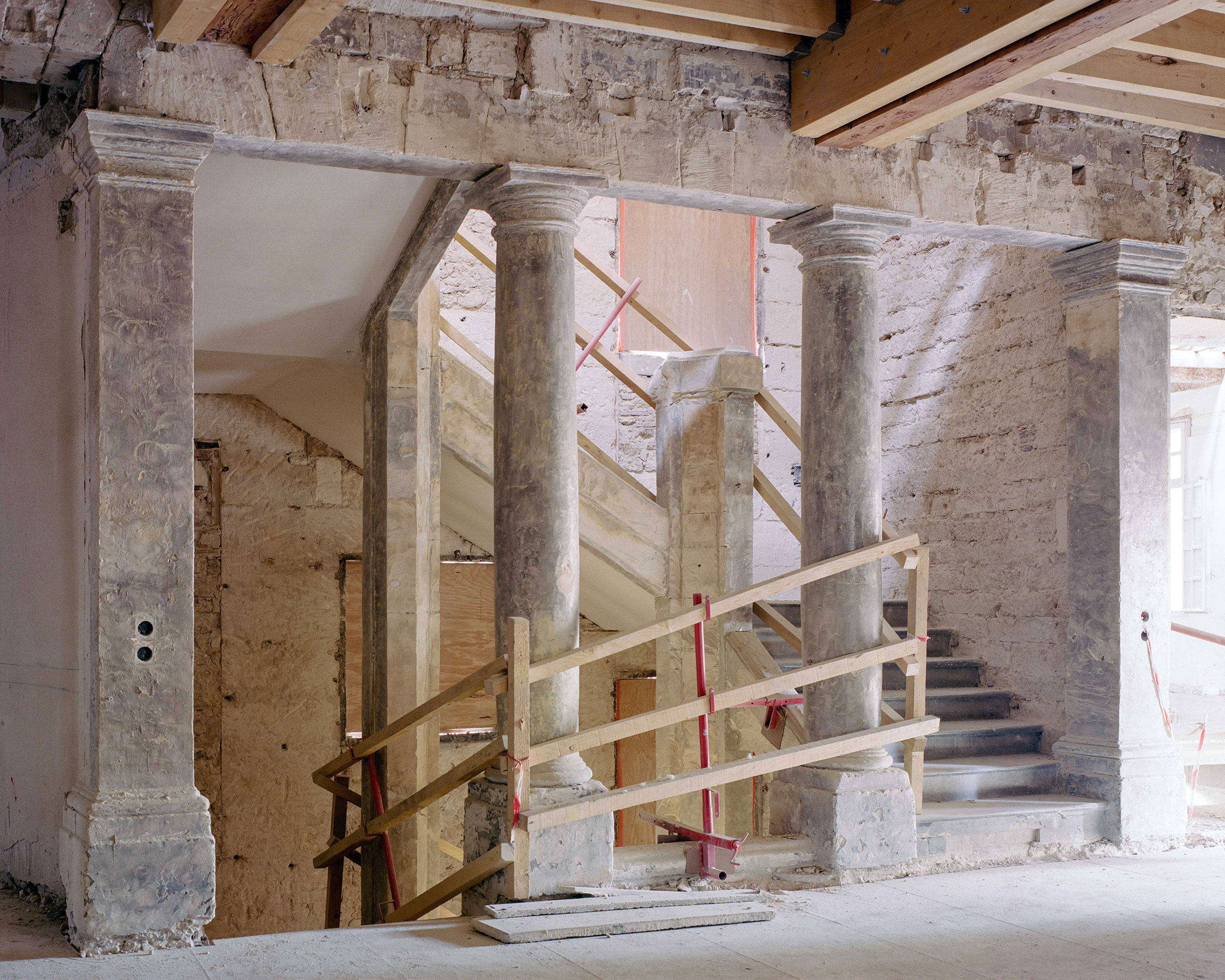
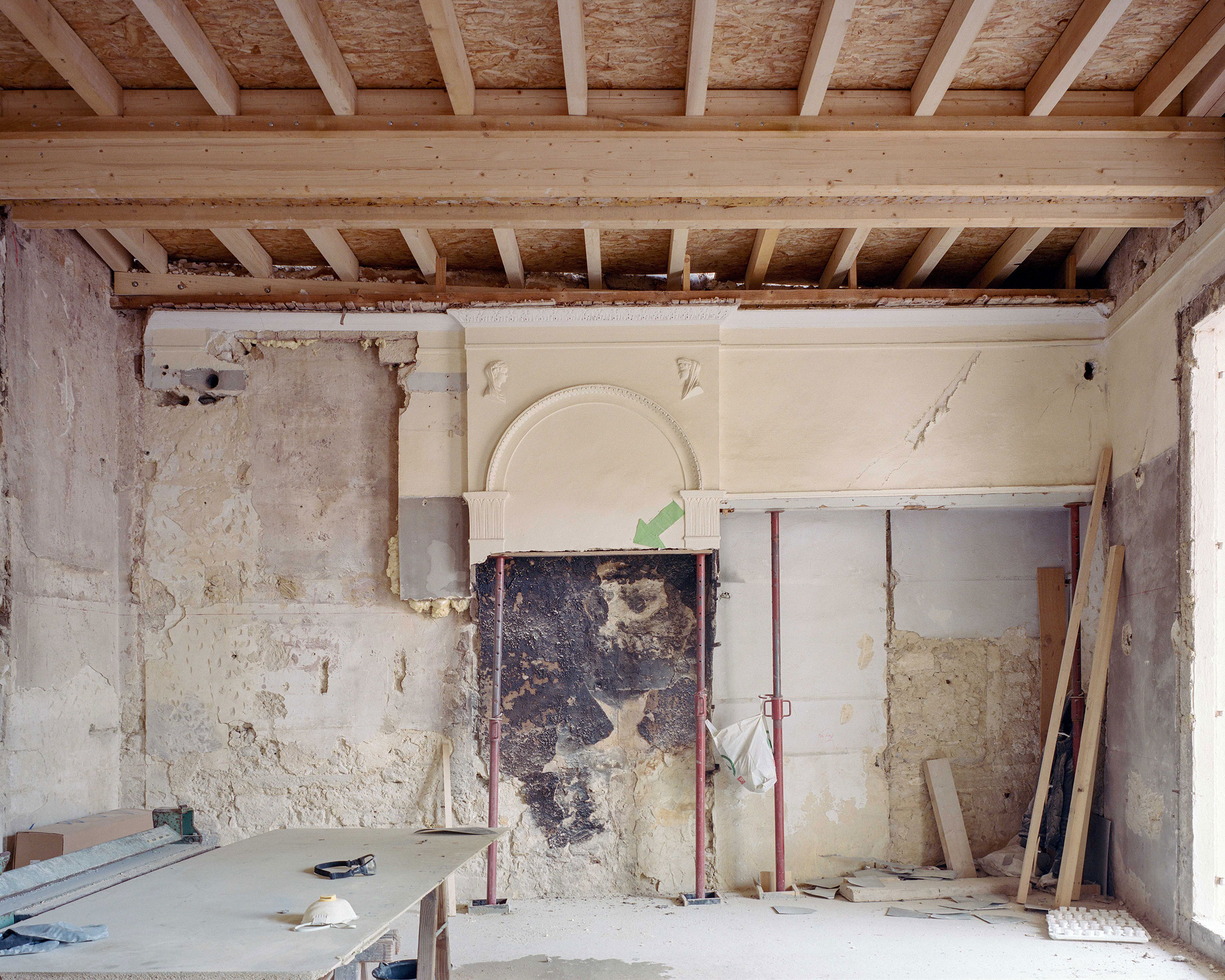
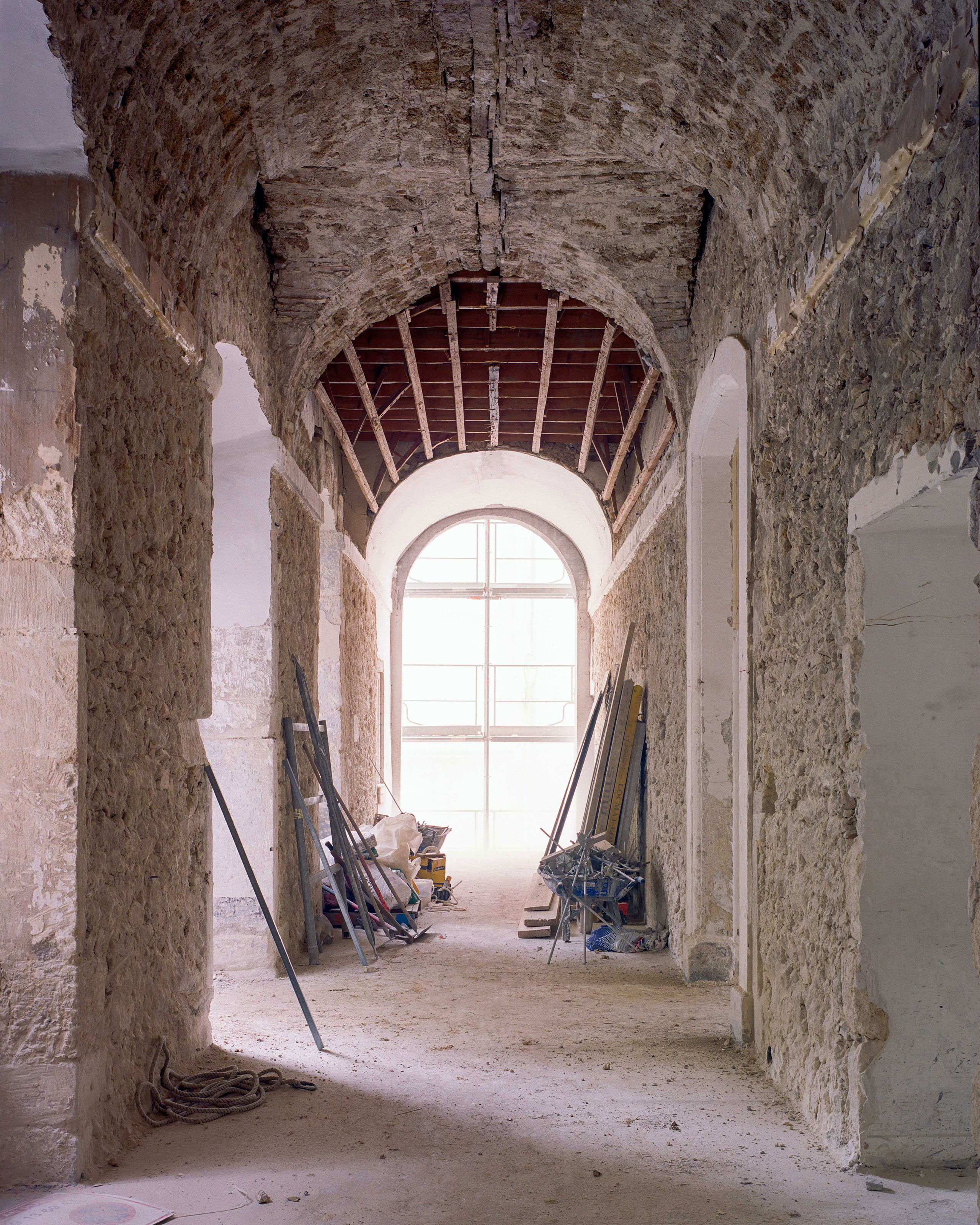
其他介入手法则充分运用了木材:从实木到穿孔墙板,再到纤维材质的吊顶,以及用来优化入口区域并隐藏技术设备管道的定制家具。
Other interventions favored timber in all its forms: from solid or perforated wall panelling, to fiber ceiling, and custom furniture installations to refine the entrances and conceal technical ducts.
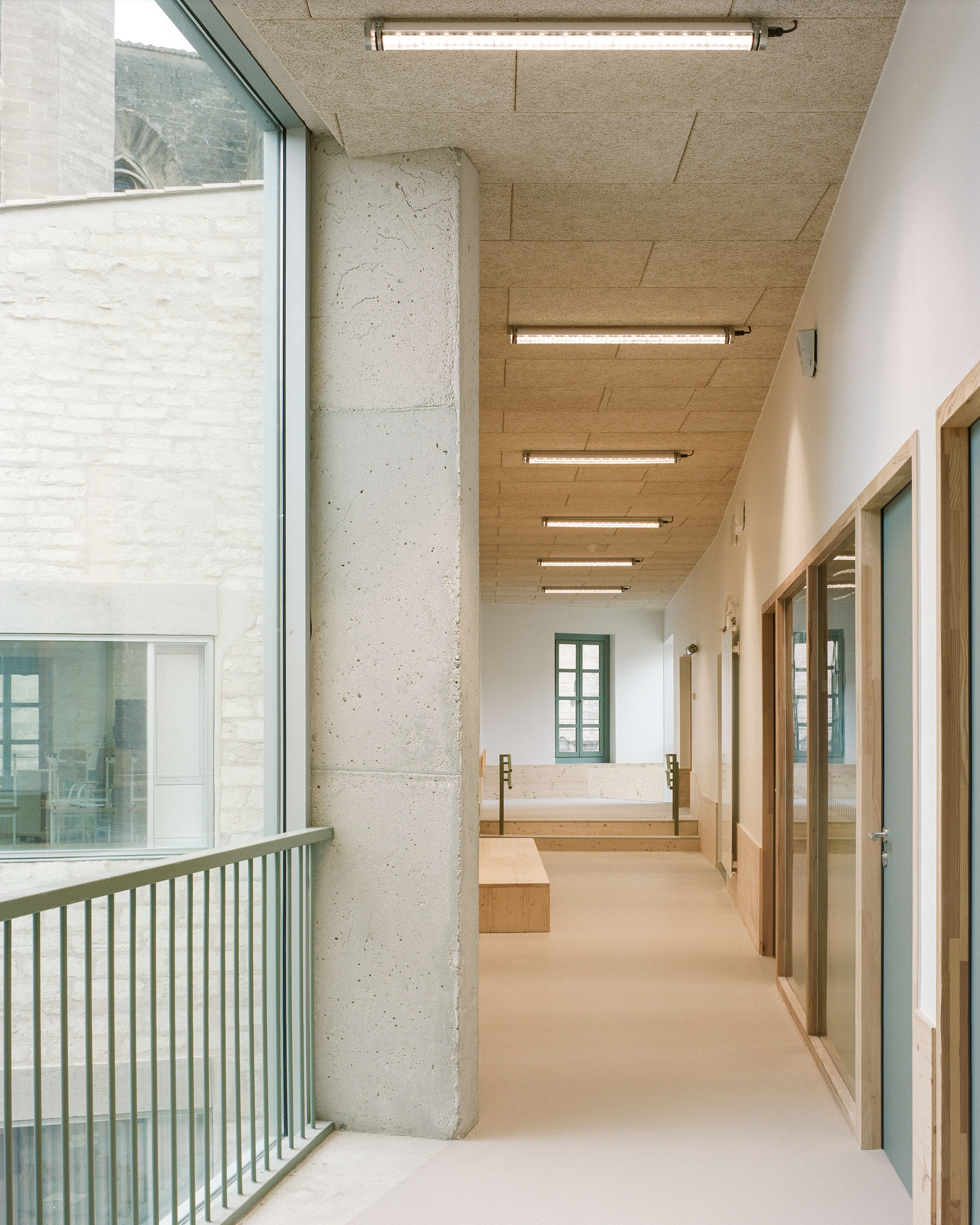
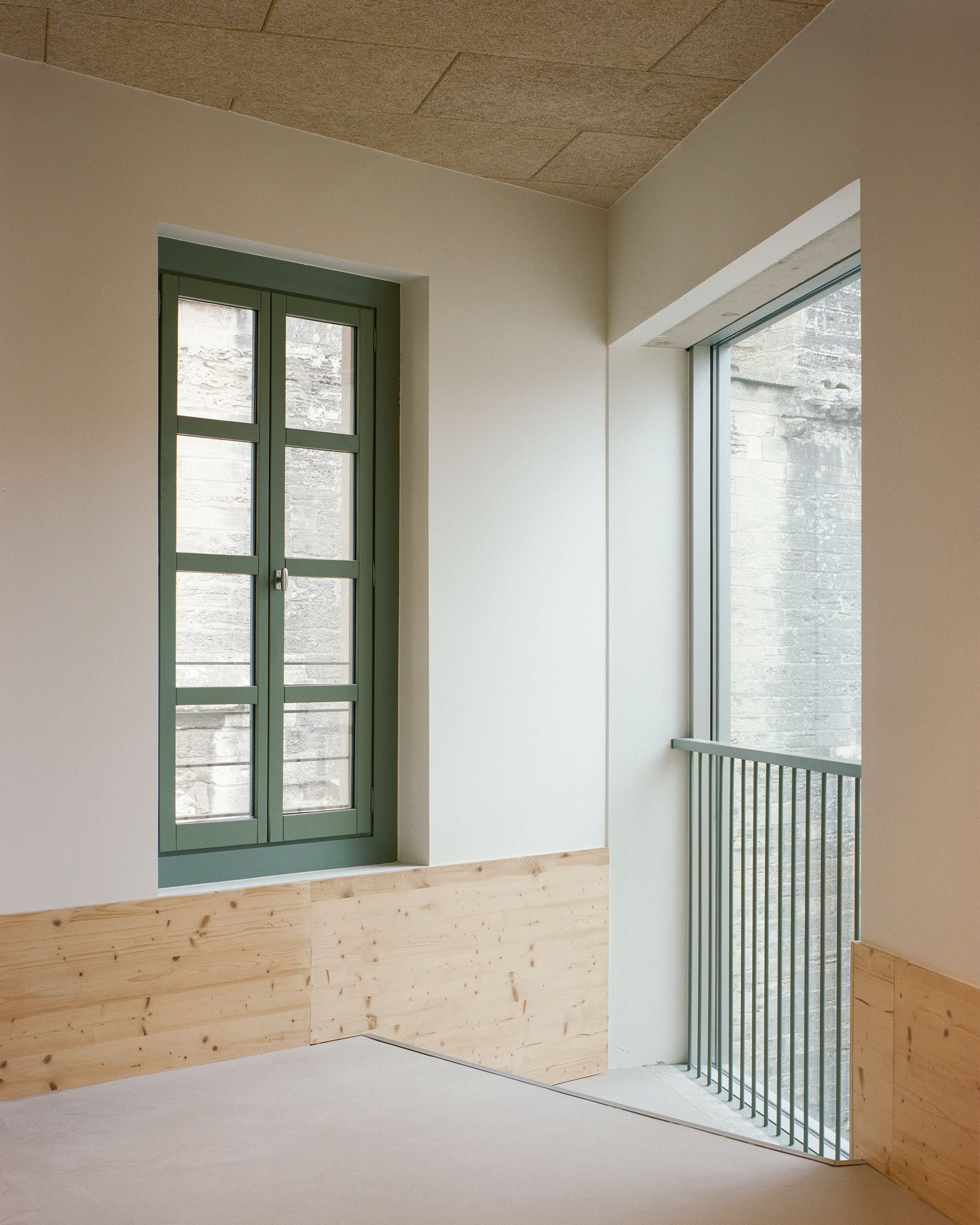


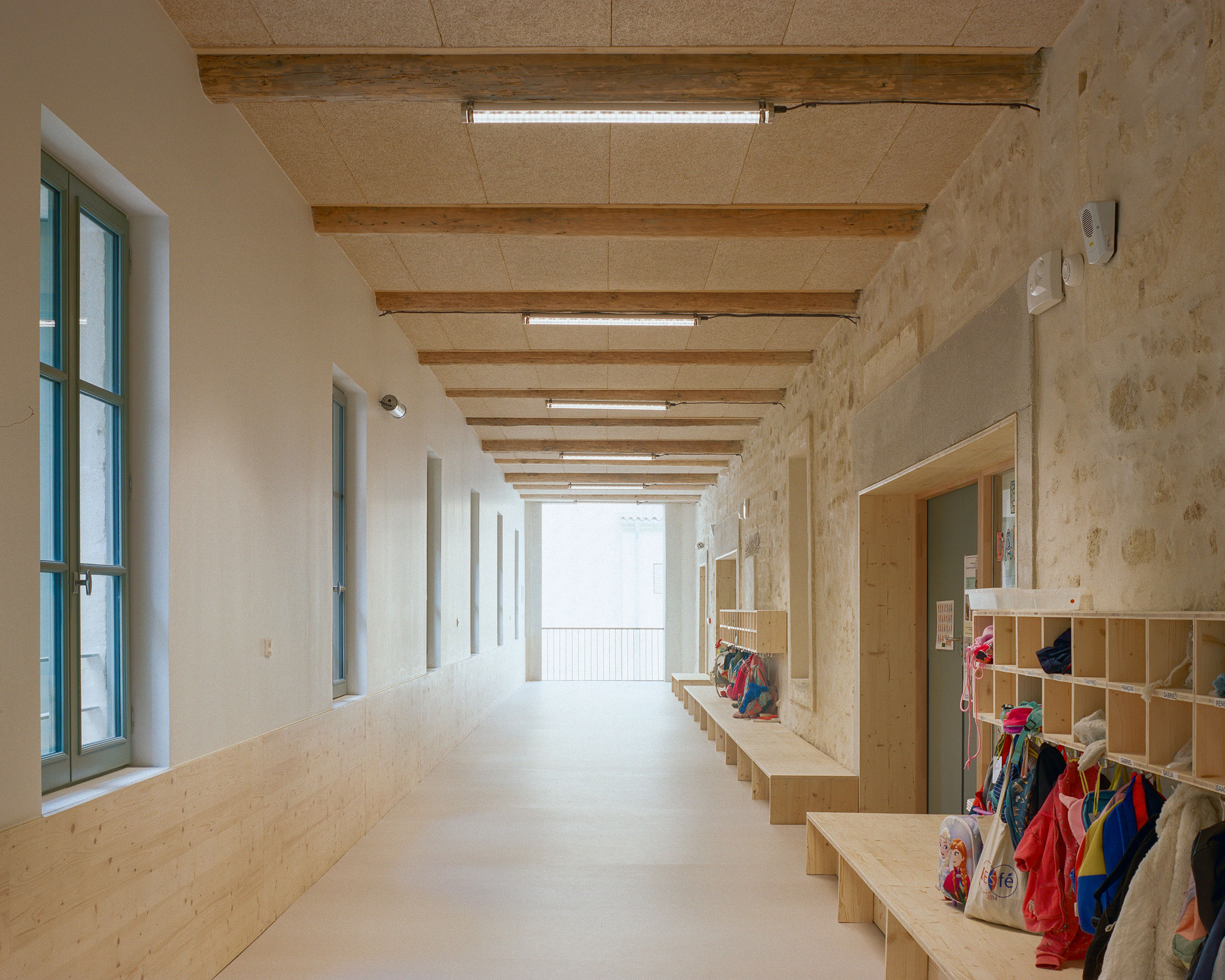
所有楼板都被拆除,仅保留主梁。新的地面系统采用的施工工艺能够保留下方主梁可见,并使用陶粒砂浆找平层和适用于教室的吸音地面材料。这样的做法是希望为现代小学创造出最优质的学习环境。
All floors were entirely removed, leaving only the main beams exposed. A new floor system was installed using a technique that preserved visible beams below, completed with a clay-bead screed and finished with appropriate acoustic flooring. These choices were made to provide optimal learning conditions aligned with the expectations of a contemporary primary school.
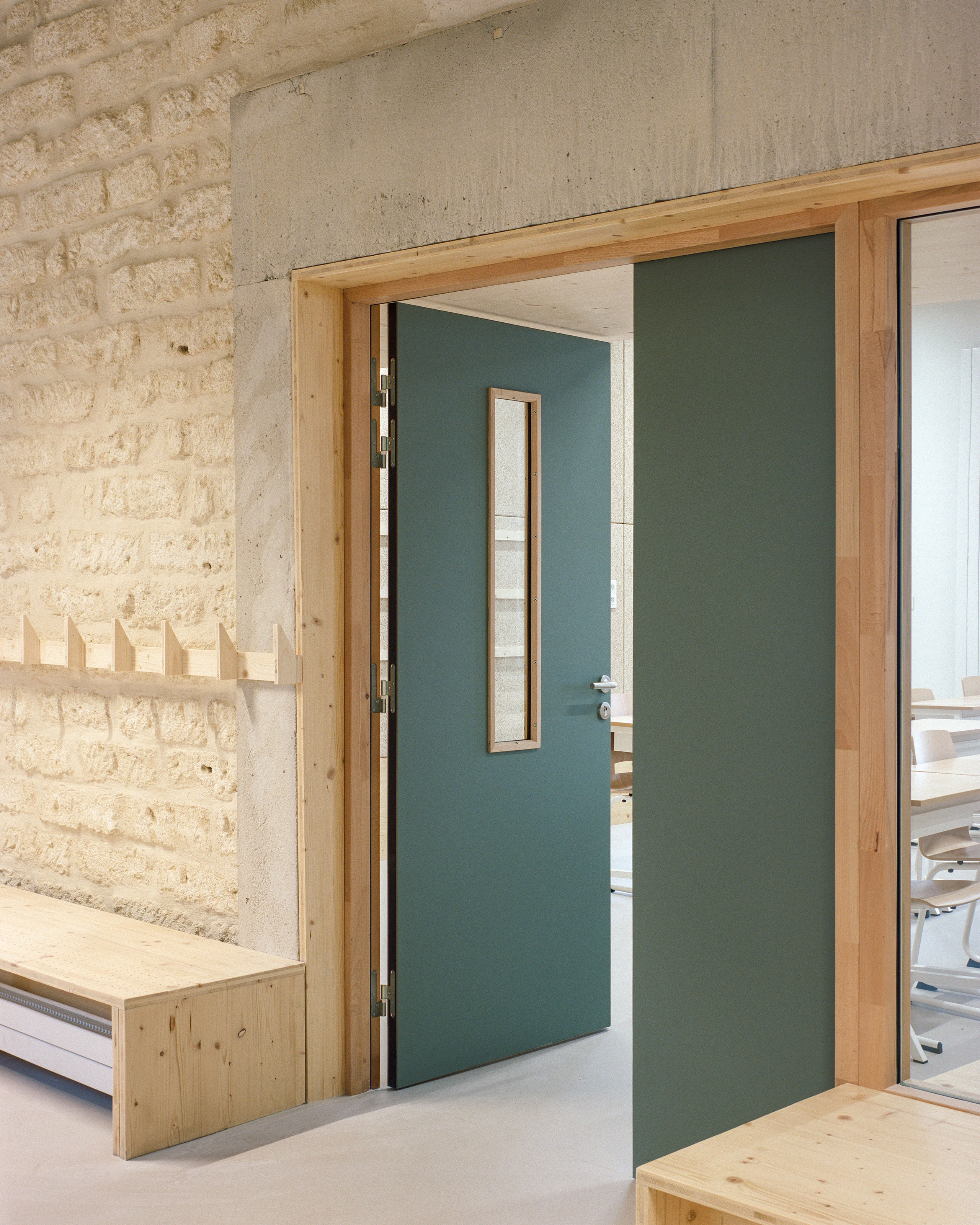
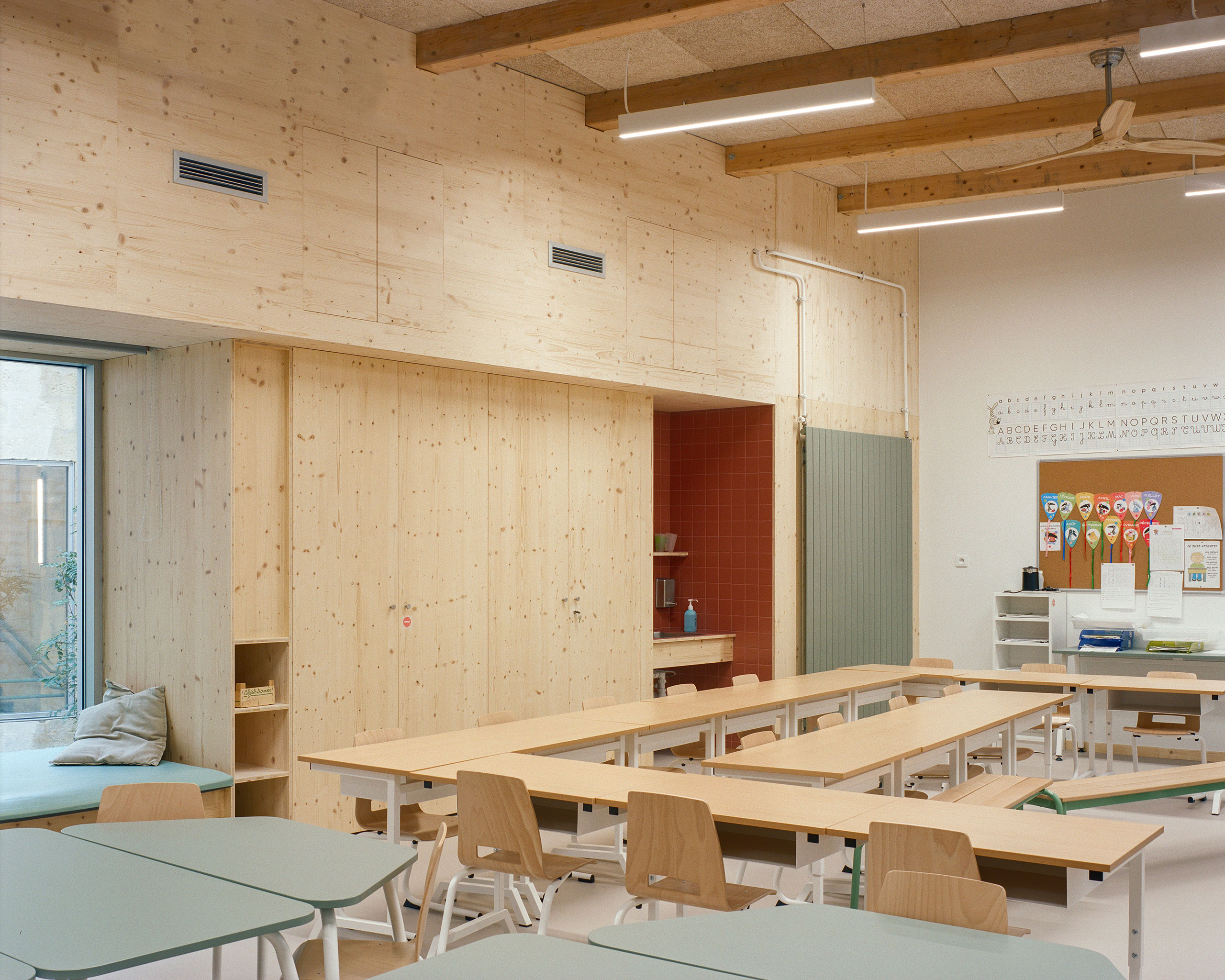

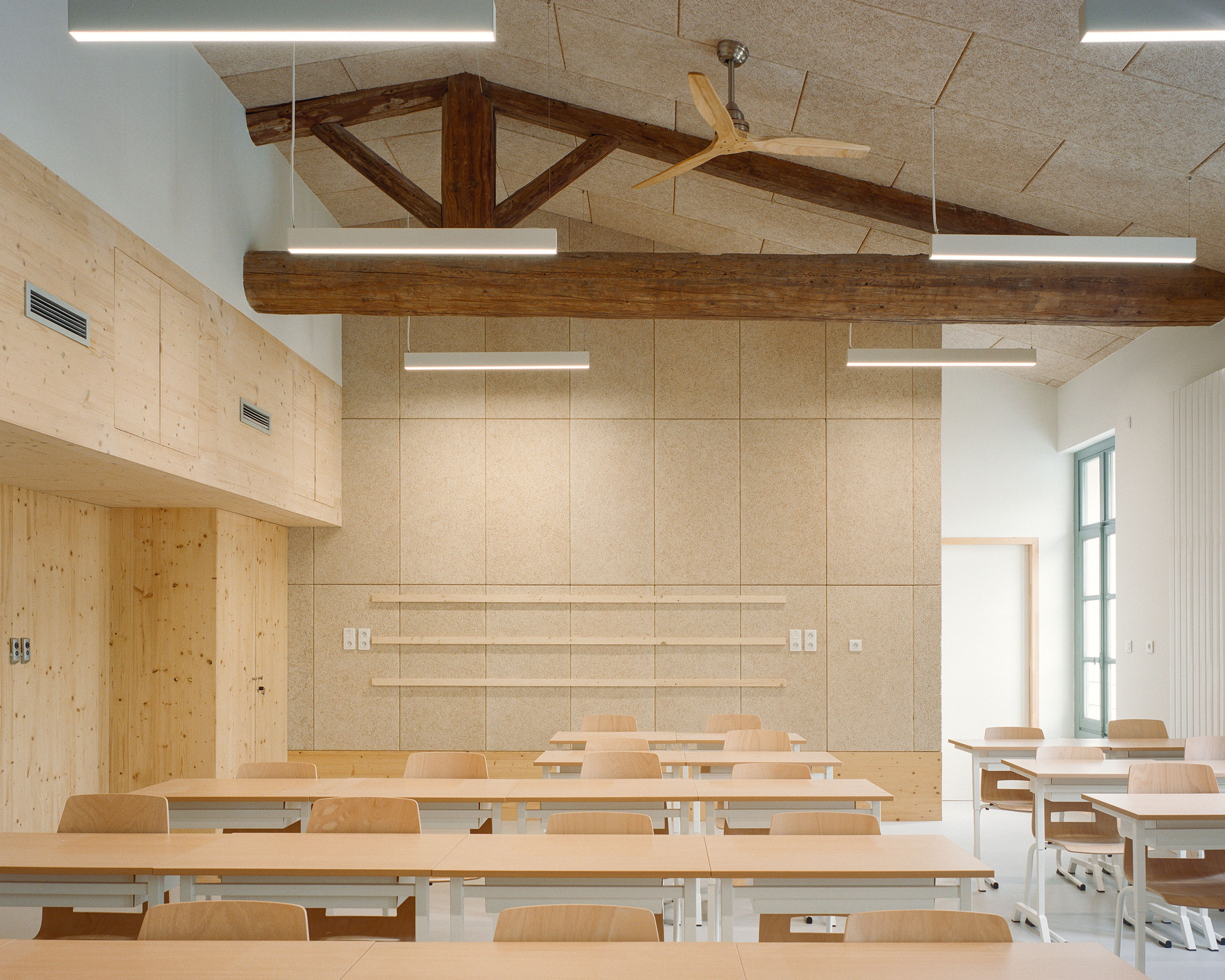
皮埃尔与科莱特·苏拉热小学成为了这片场地多重历史用途之间的桥梁,接纳了其多层次的历史特质——将其打开、划分层次、重新诠释,使其在蒙彼利埃市中心承担起全新的重要角色。
The Pierre and Colette Soulages Primary School acts as a bridge between its many past uses, embracing its palimpsestic heritage—exposed, layered, and reinterpreted to serve a vital new role in Montpellier’s city center.
通过审慎的“减法”,项目将光线、空气与景观重新引入建筑的每一个角落。在这里,建筑本身成为了一种教育工具,通过可见的线索、痕迹与谜团,激发孩子们对这片丰富历史场地的好奇心。
Through thoughtful subtraction, the project brings light, air, and views back to every corner. Here, architecture becomes a pedagogical tool, nurturing children’s curiosity through visible clues, traces, and mysteries from the site's rich history.
设计图纸 ▽

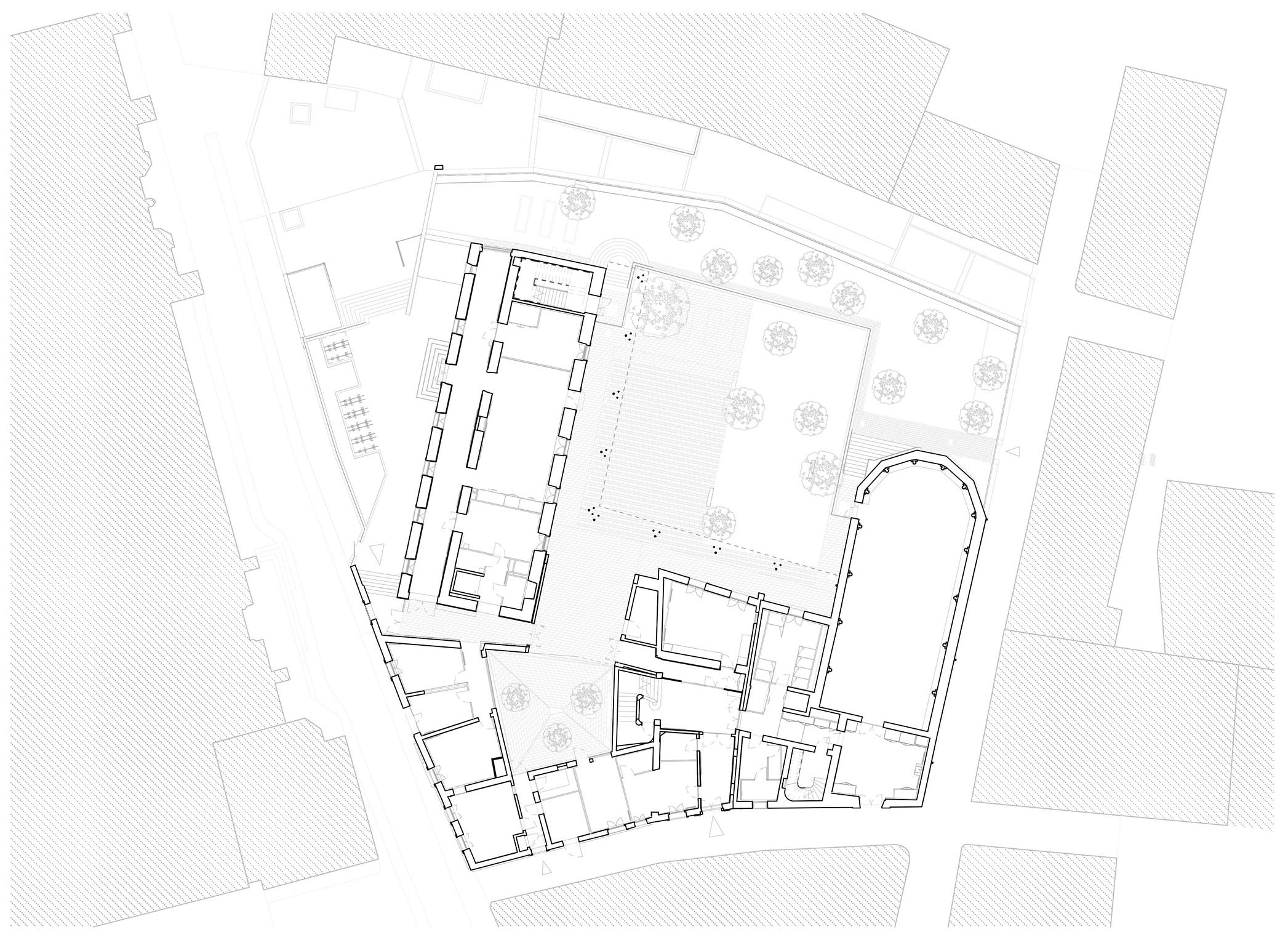
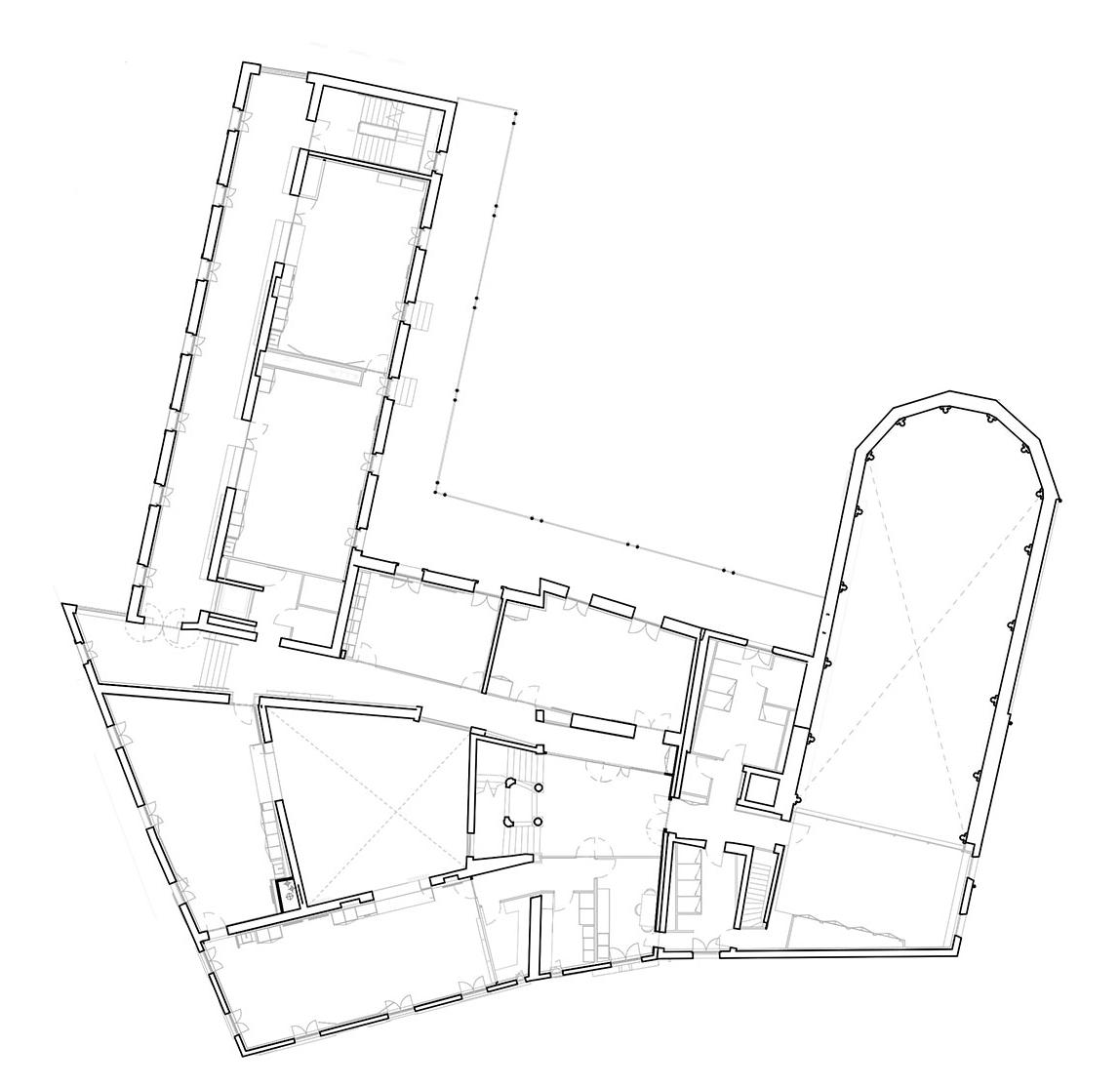
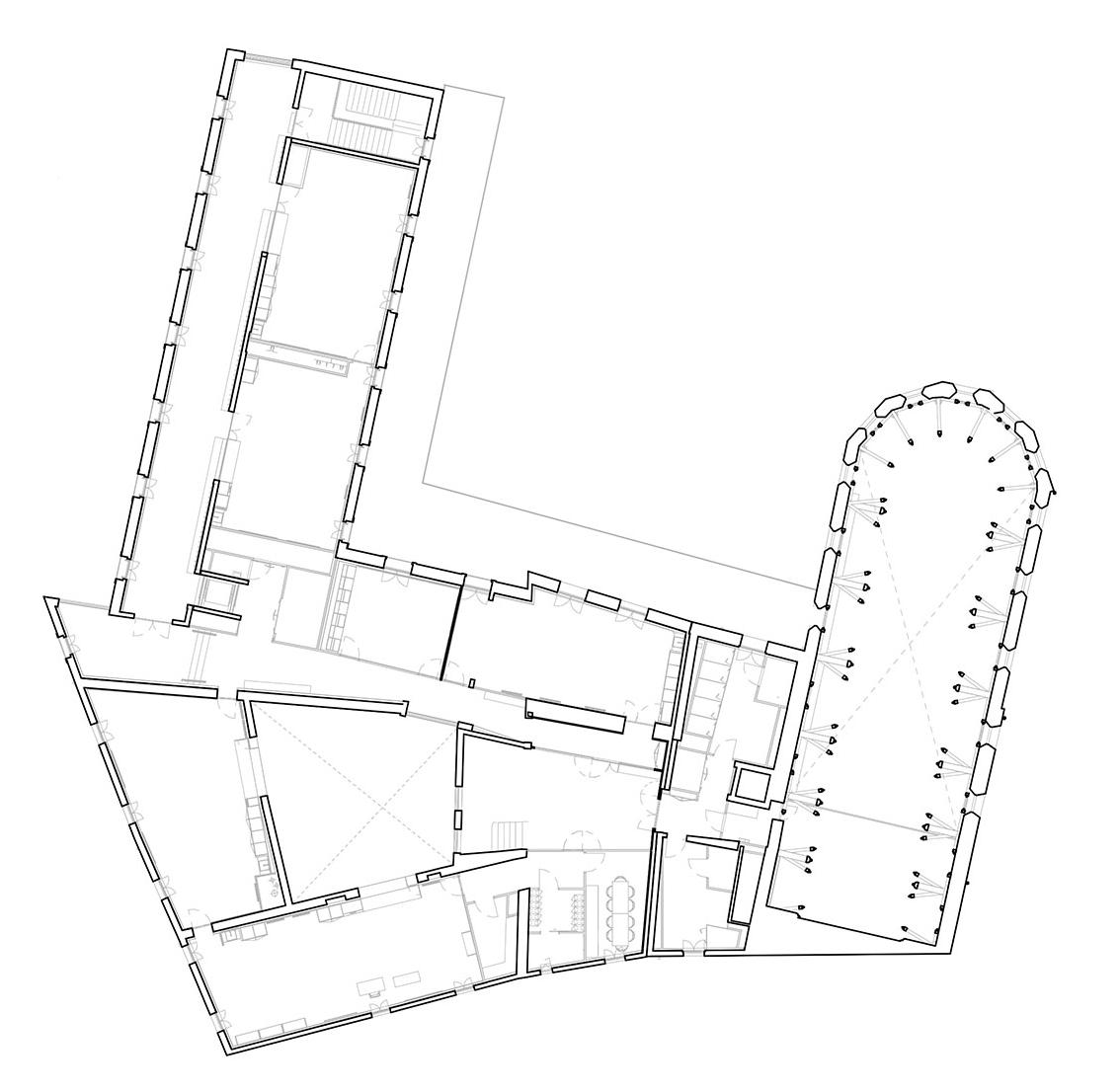
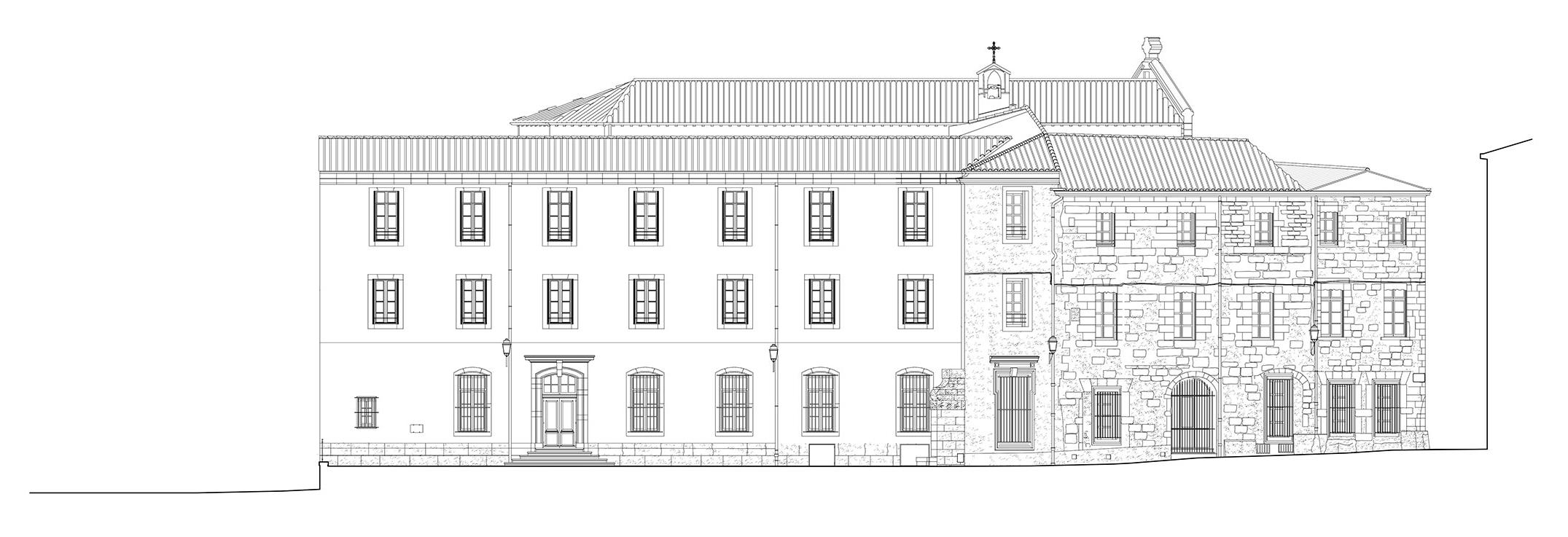

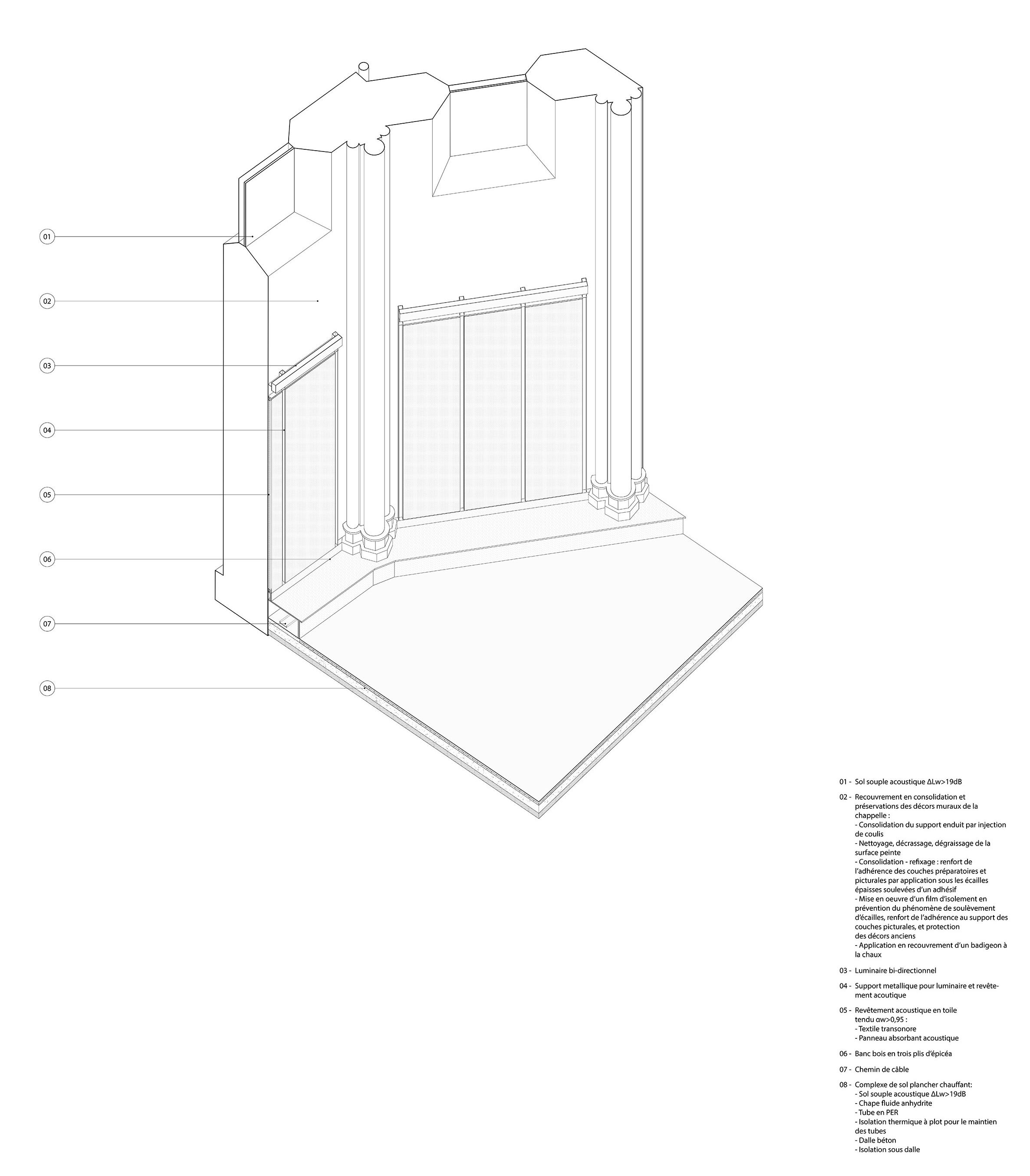
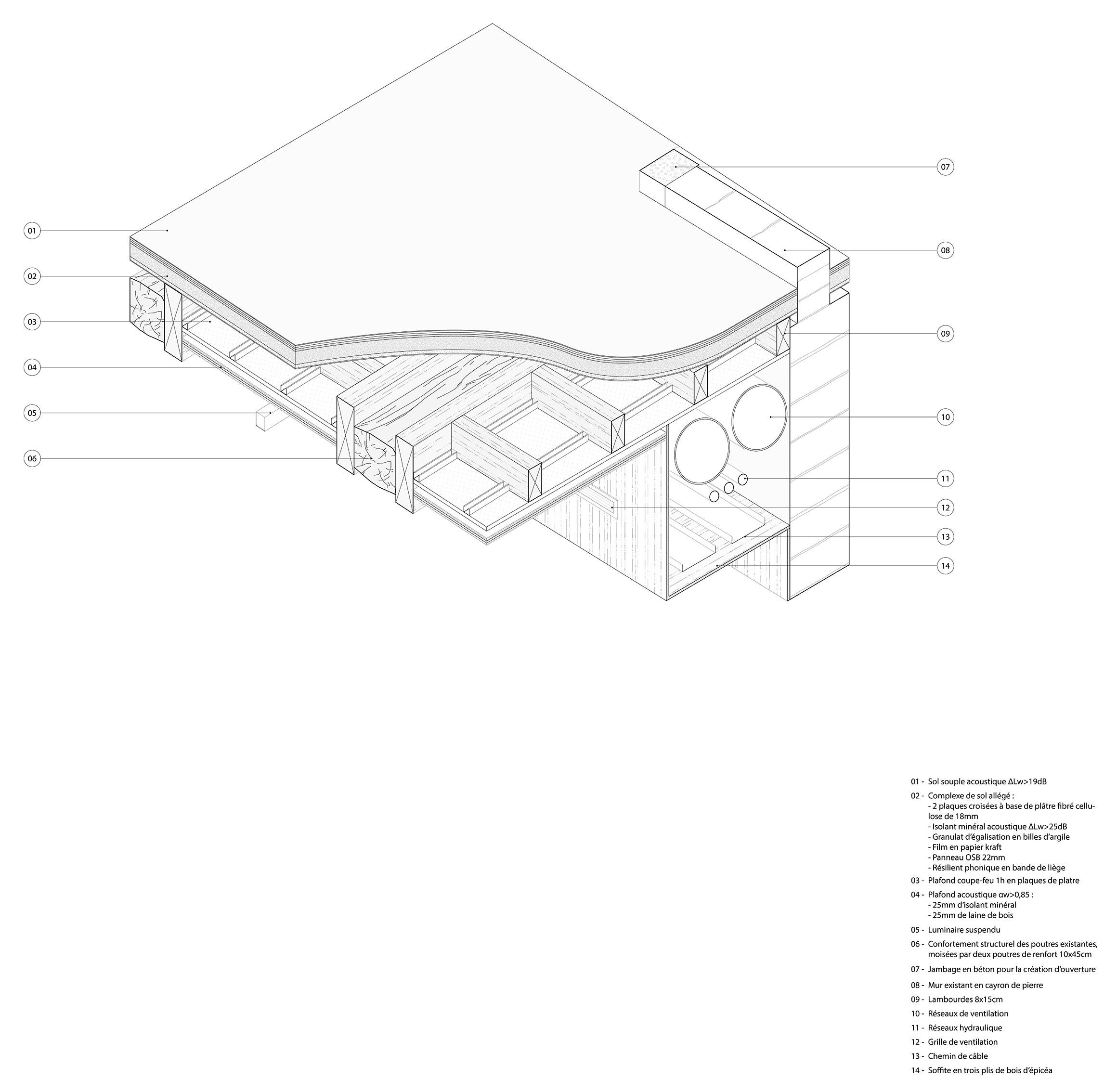
完整项目信息
Project Name: Pierre and Colette Soulages Primary School
Location: Montpellier, Hérault (34), 3 Rue du Candolle
Client: City of Montpellier
Surface Area: 2,350 m² (interior) + 1,150 m² (exterior)
Program: Primary School (4 Kindergarten Classrooms, 5 Elementary Classrooms, Activity Room, Dining Area, Shared/Common Spaces)
Schedule: Tender – 2019, Completion – 2025
Project Team: NAS Architecture (Lead Architect), GTA (Associate Architect), EUPALINOS (Heritage Architect), ESKIS (Landscape Architect), P3G (Multidisciplinary Engineering Consultant), GAPIRA (Fire Safety Coordinator), SIGMA (Acoustic Consultant), BPTEC (Cost Consultant)
Photography: ©Severin Malaud
本文英文原文及图片由NAS Architecture授权有方发布,编译版权归有方空间所有。欢迎转发,禁止以有方编辑版本转载。
上一篇:UMBAU · 改建,不间断转变|gmp改建项目精选
下一篇:青山周平B.L.U.E.在建方案:广州阿那亚理想国酒店